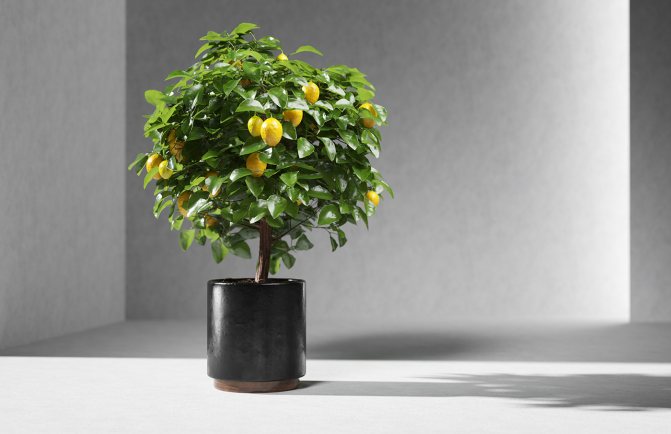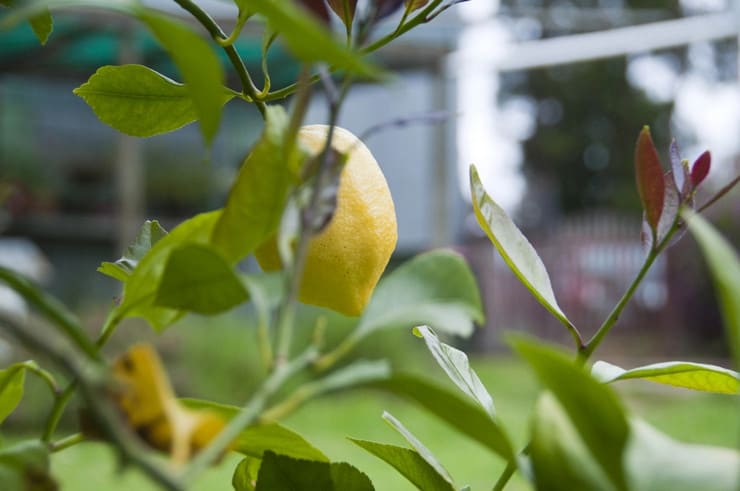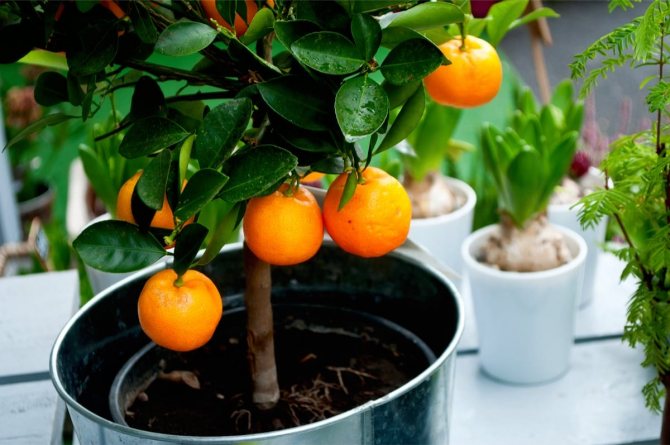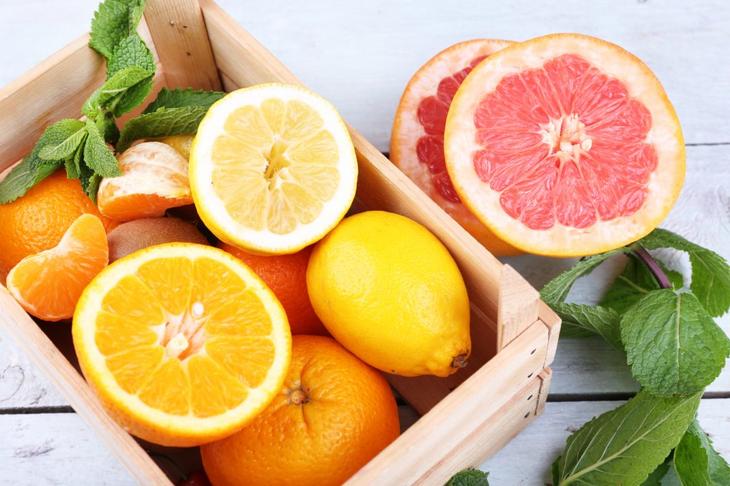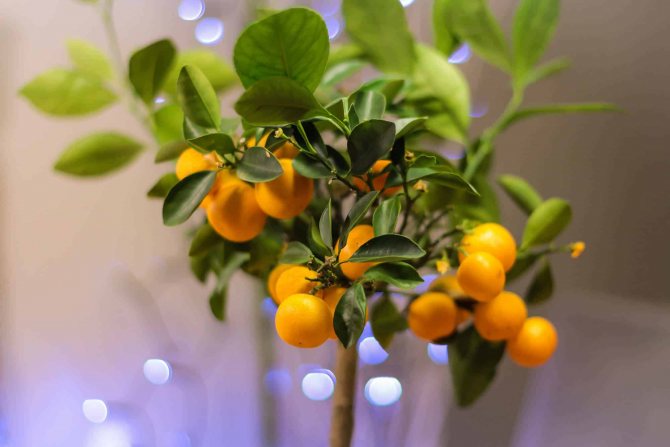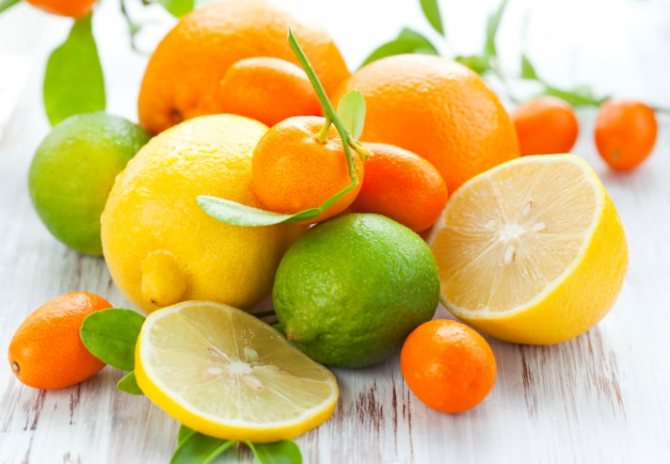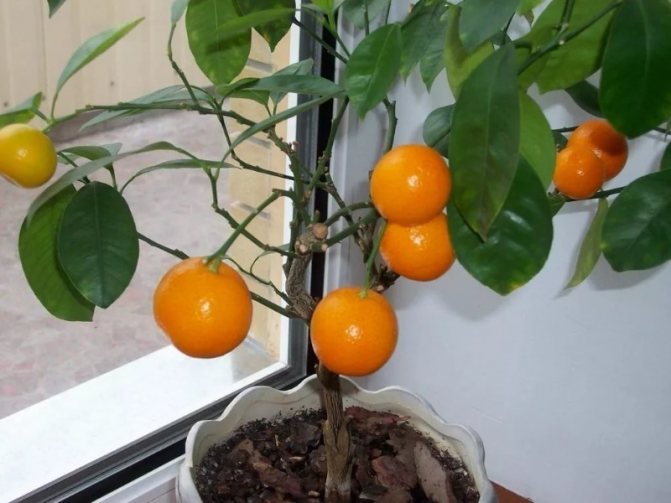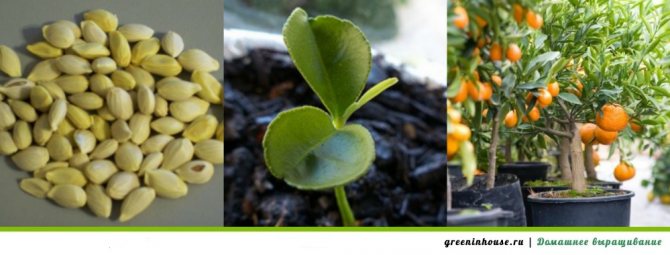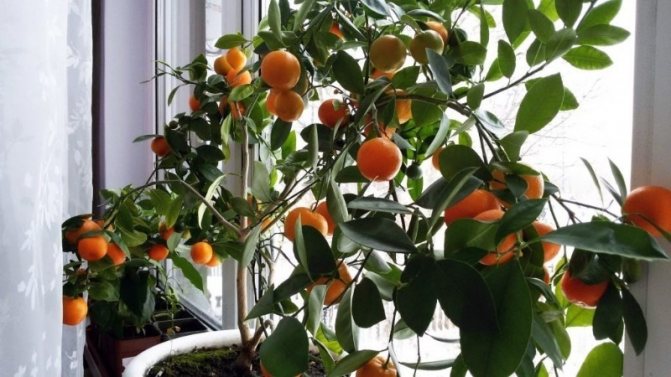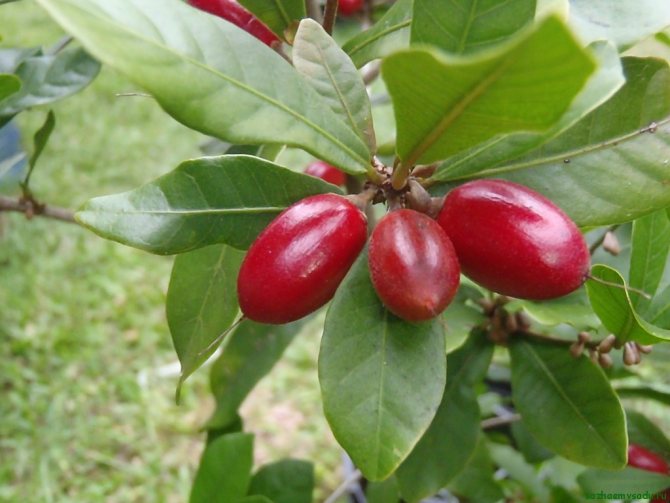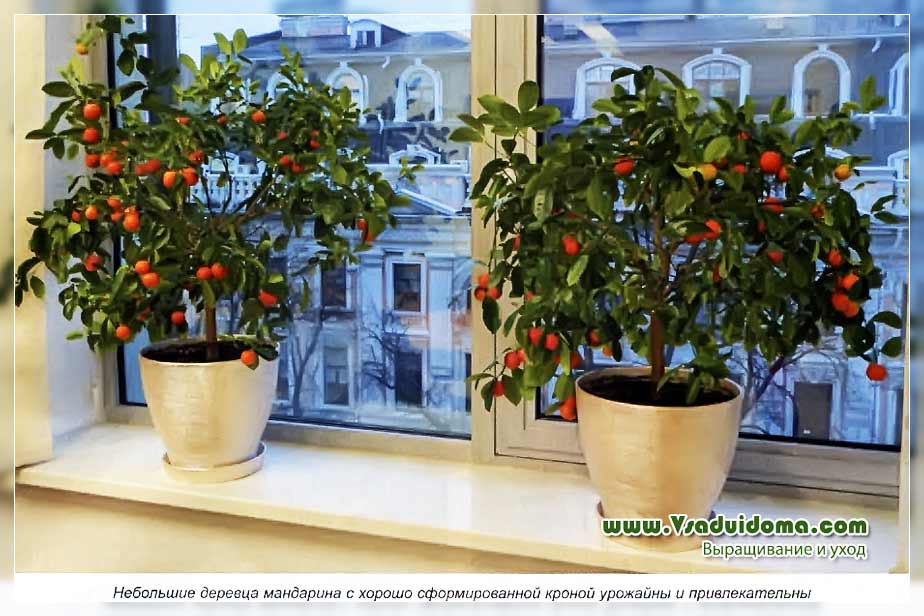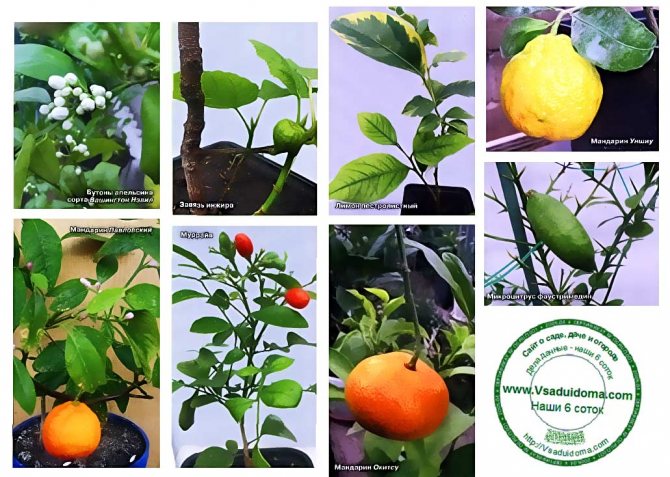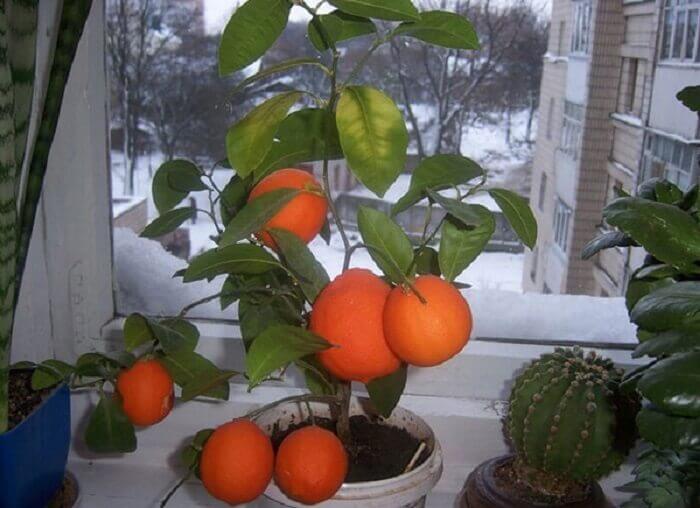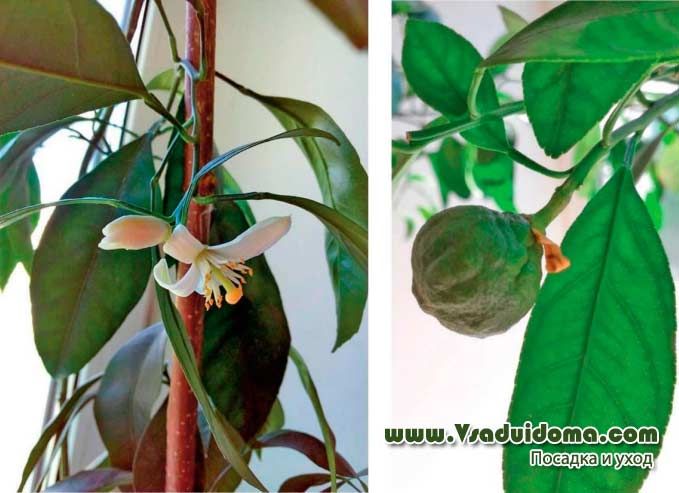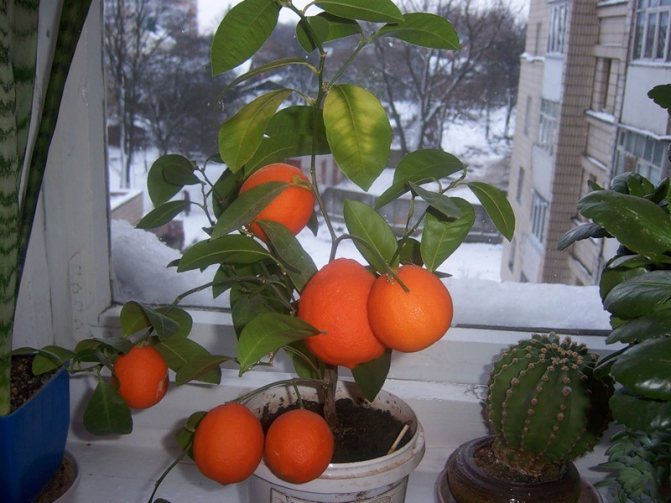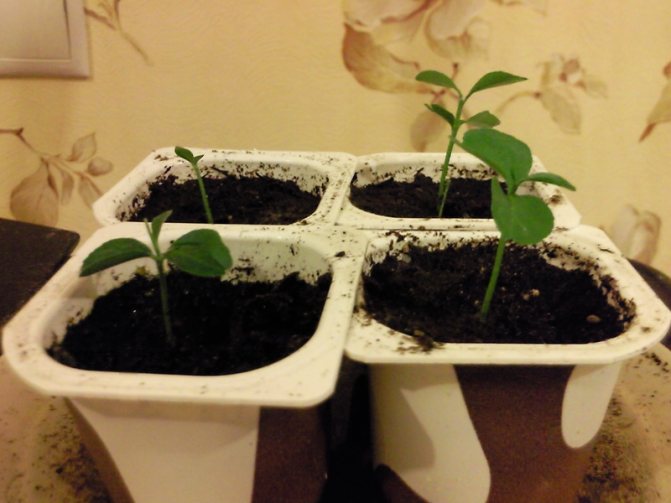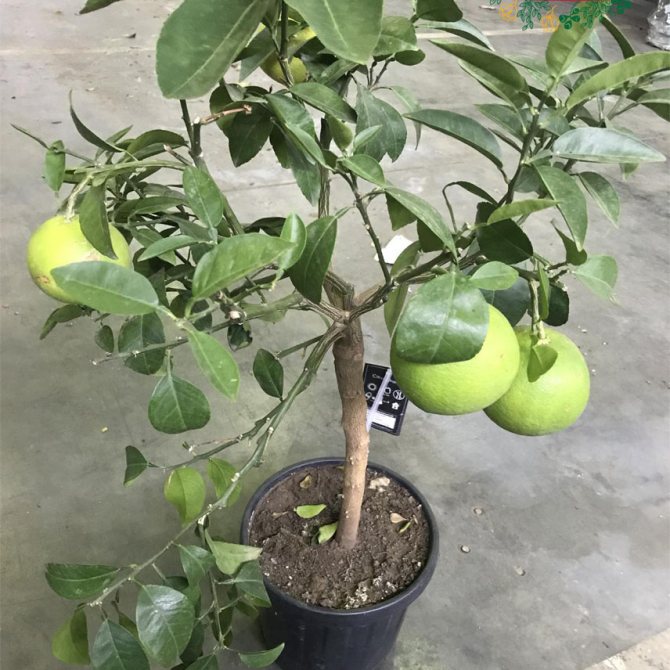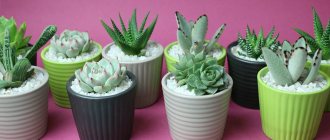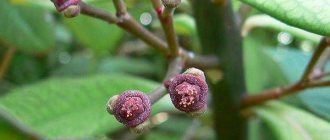Gardening »Citrus
0
775
Article rating
Growing indoor citrus plants is easy. To get beautiful fruits of exotic cultures, take into account that in nature they grow in subtropical and tropical climates. Similar conditions should be created at home, then the result will not be long in coming.
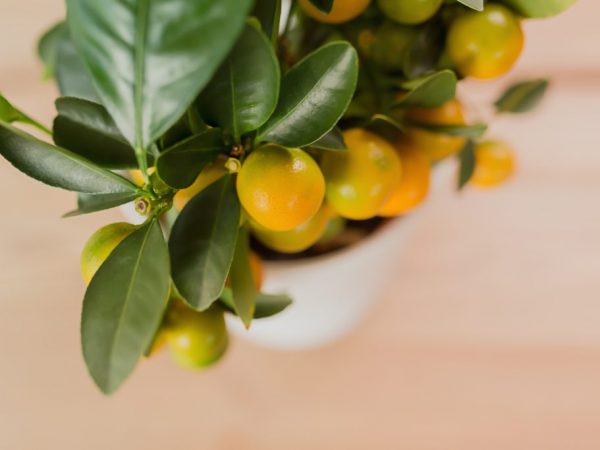
Features of growing indoor citrus fruits
Features of growing citrus at home
Taking care of citrus fruits at home is simple. It is enough to provide the plants with comfortable conditions. What is important to pay special attention to?
Content temperature
A low or too high air temperature will negatively affect the development of the plant - the tree will simply stop growing, become weak and may even die.
Comfortable temperature conditions for citrus fruits are:
- in summer - from +18 to +26 degrees;
- in winter - from +12 to +16 degrees.
Exposure to negative temperatures will be detrimental to the plant.
You can not expose the plant to sudden changes in temperature regimes, this may result in the foliage being thrown off.
In summer or late spring, a citrus tree can be taken out onto the balcony, but it is important to protect it from open sunlight that can burn the leaves, which will also provoke leaf fall.
Illumination
In nature, citrus fruits grow in hot regions, they are constantly under the scorching rays of the sun. But at home, such conditions for a flower cannot be created. The plant must be placed in the bright part of the room, but it is important to ensure that the bright rays of the sun do not fall on its surface.
The lack of light is very difficult for citrus fruits - the leaves on the trees begin to turn yellow and fall off. If it is not possible to provide the plant with natural light, then it is necessary to provide it with artificial light.
Watering
Citrus trees need moderate and regular watering. Be sure to have a layer of expanded clay at the bottom of the flowerpot; moisture must not accumulate at the roots.
In the winter season, watering is reduced, but it is necessary to avoid drying out the soil. If the plant is near heating devices, then it should be regularly sprayed with warm, settled water.
- moderate watering;
- elimination of drying out of the soil;
- regular spraying in the evening.
Fertilizers
The introduction of root dressings is carried out only during the period of plant activity, that is, from the beginning of March to mid-September. During the resting period (winter), citrus fruits do not need additional nutrients.
Fertilizer options for citrus trees:
- Baikal;
- Vostok-EM1;
- Revival.
Optimal growing conditions
Growing citrus fruits requires providing them with an appropriate microclimate.
Temperature regime
In order for the plants to thrive, they are supplied with heat. Optimal performance should be at the following level:
- 18-26 ° С in summer;
- 12-16 ° C in winter.
It is strictly forbidden to keep fruit trees at low temperatures.
Be sure to monitor that the temperature indicators for the crown and root system are at the same level.If the roots are in cooler ground, they have no time to consume water. Otherwise, the moisture saturation will be too high.
It is taken into account that keeping indoor citrus plants on the floor requires the installation of a special stand: below the temperature is always lower. It is provided if a floor heating system is installed in the room to prevent overheating.
In spring and summer, tree pots are taken out to the balcony or garden. They develop well there. Indoor citrus plants shade, since direct sunlight tends to overheat the soil, then the roots get burned. They are returned to their original place in the fall. But it is not too late, so that a sharp change in conditions does not happen, otherwise the leaves will begin to fall off.
Illumination
Light-loving cultures. The best place for them is southeast or southwest windows. At lunchtime, the trees are shaded. In the cold season, they are supplemented with daylight lamps or phytolamps. Daylight hours should be 12 hours. Longer lighting prevents citrus indoor plants from developing properly.
Air humidity
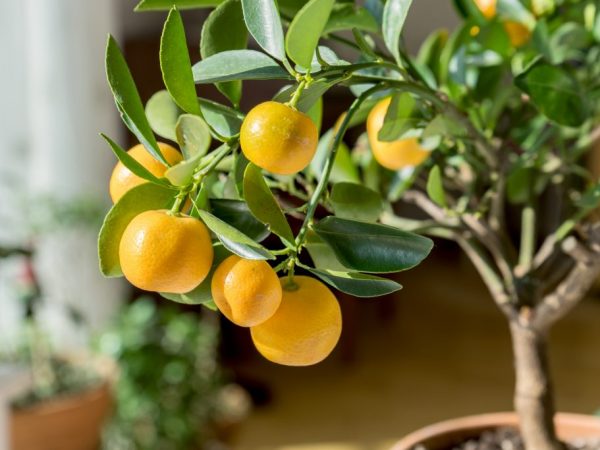

Spray the plants regularly
Trees naturally grow in an environment with high humidity. Indoors, they are increased by spraying the leaves. A household humidifier is also used.
Outcome
- Growing citrus trees at home will not be difficult if comfortable conditions and proper care are created for the plant.
- For growing at home, it is recommended to choose decorative citrus varieties, characterized by small growth and unpretentiousness.
At home, although interesting, it is far from simple. Therefore, those who believe that it will be enough to plant a bone in the ground, and that's all - lemons for tea are no longer necessary to buy. Without special knowledge, the first harvest of citrus indoor plants, if they do, will not earlier than in twenty years.
But if you know some of the nuances and grow correctly, observing all the rules, then you can enjoy the fruits much faster. But even here it is important not to make a mistake in choosing a variety. For growing on a windowsill, only those citrus indoor plants that have been grafted on seedlings of orange, lemon, grapefruit or kumquat are suitable. Those crops that were grown from cuttings cut from fruit-bearing trees have also proven themselves quite well.
The most unpretentious citrus indoor plants. Features of indoor varieties
Many people like growing citrus fruits at home because:
- the plant has a beautiful decorative appearance;
- subject to the rules of care, you can achieve good fruiting;
- the presence of healthy fruits on the table throughout the year.
At home, various varieties of citrus fruits are an evergreen tree that pleases the eye with its rich green crown. In this regard, citrus fruits are similar to coniferous varieties.
However, they periodically shed some of the leaves, which in the conditions of the house can be perceived by the owners as a disease. Therefore, you need to be familiar with such a feature of these plants in order to avoid unnecessary actions and not ruin the tree with your excessive care.
The main feature of these plants is that they do not tolerate low temperatures poorly. Therefore, it is not recommended to place the plant in the path of drafts, otherwise the foliage will begin to fall off.
Citrus plants have the following botanical features:
- a tall tree, even at home, can be grown with just one seed. It can be extracted from any store-bought fruit. However, it should be understood that improper cultivation in the house will lead to a lack of flowering;
- the fruits of any citrus, be it tangerine, lemon or orange, always have a bright peel;
- citruses that have formed on a tree grown in the house cannot always be eaten;
- citrus fruits removed from a house tree may have an uncharacteristic taste;
- flowering in a young tree begins only after a few years of life;
- the roots here are thick and devoid of thin fibrous processes, which are characteristic of the fruit trees we are used to;
- unlike its wild relatives, the houseplant is much smaller in size. Depending on the cultivation method, you can get a tree several meters high or a neat mini-plant in an ordinary flower pot.
It should be noted that homemade citrus is an unpretentious plant. Caring for him is simple and unassuming. The main thing here is to choose the three most important parameters correctly: lighting, humidity and temperature. After all, these plants in the wild live in subtropical and tropical climates. Accordingly, their indoor varieties need to create appropriate conditions for growth and flowering in a house or apartment. If everything is done correctly, it will not be difficult to take care of the tree. Do not forget that each species (orange, lemon or tangerine) has its own characteristics and characteristics, which determines their care.
The cultivation of these plants will be organized correctly if the tree has a well-developed crown with a sufficient number of leaves.
Difficulties in growing homemade citrus plants
It would seem that it is simpler: you need to go to a flower shop and buy a pot in which a flowering or already bearing citrus grows - a "golden orange", a Meyer's lemon, which is not very difficult to take care of at home, or a tangerine. The tree just needs to be brought home, placed on the windowsill in the right place, and started to water. But this is not at all the case, since it is really difficult to grow a lemon or tangerine at home, moreover, this process is somewhat different from caring for ordinary specimens.
The plants that are sold today in flower shops most often come to the shelves from abroad, mainly from Holland. There they are kept in ideal conditions from the first day: the optimum temperature for growth, high humidity are maintained, supplementary lighting is supplied, and fertilizers for citrus indoor plants are constantly applied to the soil. When buying on dwarf trees, by the time they are sold, there may be a dozen or more fruits.
But after getting on the windowsills, beautiful citrus indoor plants immediately begin to face stressful conditions. In our houses, the illumination is much lower - several times, and the air (especially in winter) is incredibly dry compared to the greenhouse, and growth stimulants stop helping after a while.
Therefore, in conditions of a shortage of their internal resources, citrus indoor plants begin to throw all their strength into preserving the fruits with which they were so abundantly strewn in the store. And as a result, the vast majority of purchased "pets" die.
Winter maintenance
The dormant period for citrus crops lasts from November to February. To grow a beautiful fruit tree, you must ensure that it has a proper wintering period.
Citruses require a mandatory drop in temperature during the cold season. Under natural conditions, they receive a lot of light, the amount of which in our area in winter drops sharply. Even when growing citrus fruits on a windowsill, there is not enough illumination. Without it, plants do not receive the necessary energy for photosynthesis, and at home they spend a lot of it, so the culture is depleted. This leads to her death. To prevent the problem, the illumination must be increased.
For wintering citrus, a loggia or a greenhouse, a cool apartment is suitable. If the temperature in the house is high, a pot with a tree is placed on the windowsill, fencing it off from the room with a frame.Then it will get colder there. If these conditions are not met, the culture dies in 3-4 years.
Species suitable for growing at home
Citrus crops have long been known to man. Their people have been actively cultivating for so long that it has become difficult to detect their wild-growing ancestors in nature. Most often, citrus fruits are cultivated outdoors in countries with tropical or subtropical climates. And it is from there that their fruits are delivered to store shelves in all corners of the planet.
A novice grower who cannot pay too much attention and time to a pet growing on his windowsill should choose varieties of indoor citrus plants that are easier to care for. If we talk about subspecies for a small apartment, then it is preferable for beginners to grow lemon, tangerine and trifoliate, since their growth is easier to restrain. In turn, oranges, grapefruits or pomelo, which are large in size, turn into a rather bulky tree in a couple of decades.
As for exotic varieties, today a close relative of mandarin is quite common - citrus kumquat nagami, as well as calamondin. Speaking of amazing varieties, the Hand of Buddha must also be mentioned.
By the way
Light shading of citrus fruits from the scorching rays of the sun promotes healthy, dark green foliage. When placed in direct sunlight, the leaves of plants acquire a pale green color, and burns may appear after a gloomy winter in spring. On the contrary, in a dark room, citrus fruits gradually shed their leaves, and new leaves, if they appear, are small and deformed.
Therefore, it is recommended to keep plants in the summer on a window facing north-west or southeast (these windows are less sunny, but also less hot), and in winter - to the south and south-west, so throughout the year there will be uniform illumination for the plant. But, of course, such rearrangements are possible in apartments and houses, where the windows are on opposite sides.
You can also push plants deeper into the room in summer, and in winter, on the contrary, move plants as close as possible to the window.
With a lack of light, orange and lemon fruits are characterized by increased acidity. However, in summer, plants should be shaded from the sun in the afternoon.
Cuttings
The most convenient option for those who decide to grow a citrus crop on their own will, of course, be a young plant, which was purchased in a specialized store. But a purchased tree does not always take root in the house for many reasons. However, if, after all, the culture has migrated from the store to the apartment, you need to contact the seller and get a recommendation from him for adapting the citrus to the new conditions.
First, the plant needs to be inspected. If there are fruits on it, then they will have to be cut off. For seven to ten days, citrus should be left in a store pot, and only then transplanted into a new one.
Citrus trees grown from material obtained by cuttings take root best at home. Of course, it will be difficult for beginners who have a poor idea of how to grow tangerine, lemon, etc.
The cuttings should be cut from a well-developed and healthy citrus tree. The length of the planting material should be between ten and twelve centimeters. It must have at least three buds. It is not recommended to use either too young or old enough shoots with dense wood.
The best time for harvesting cuttings is April. Rooting of planting material can be carried out in a glass of water or in soil consisting of earth and sand. In the latter case, the cutting should be covered, for example, with a plastic bottle. The roots will appear in about twenty days.After that, the rooted stalk can already be planted in a permanent pot.
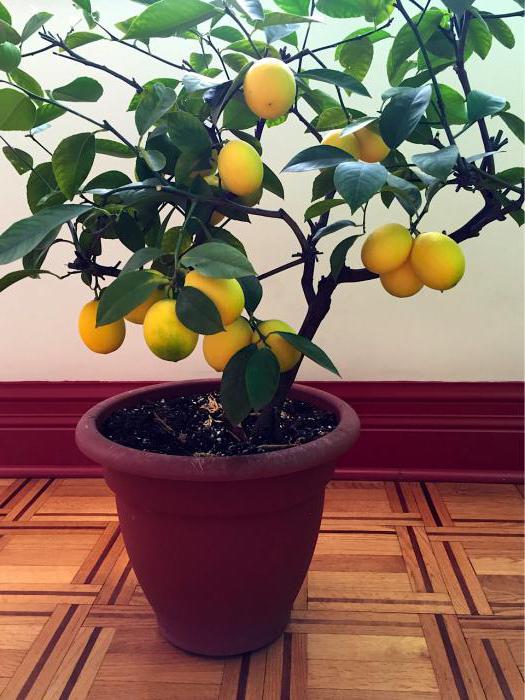

Tangerine care
According to agronomists, tangerine is a very unpretentious tree to maintain, not only among citrus fruits, but also among many other plants, but it still requires observance of certain rules when leaving. The most important condition for him is an abundance of sunlight. Mandarin requires intense lighting up to twelve hours a day all year round.
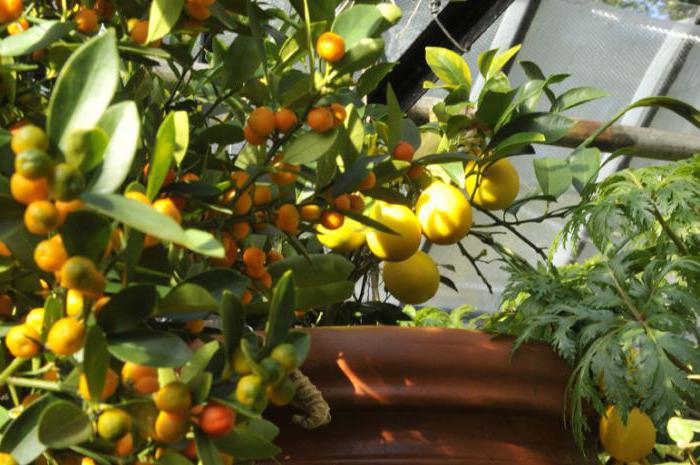

- seeds
You can often hear that a seed planted in the ground turns into a luxurious citrus tree over time. But, even despite the fact that growing tangerine or lemon from seeds is the most affordable way for amateurs to propagate this type of plant, the result is often unpredictable.
As a result, you can get a culture, the fruits of which will be much smaller than the parental form, or you can grow a new excellent pet. Judging by the reviews, the use of seeds pulled from fruits as planting material often leads to a lack of flowering in such seedlings.
The seedling begins to germinate in about a month and a half, and it should be transplanted at the stage of the appearance of five leaves.
After the juicy fruits of this citrus bought in the store are eaten, you can use the remaining seeds as planting material. For the greatest probability of success of the event, it is better to have more seeds, since definitely not all will germinate. Therefore, to obtain seedlings, you need to take a dozen seeds.
The planting material is placed in cheesecloth for several days and slightly moistened. This is necessary so that the bones, swelling, "hatch".
Tangerines can be grown at home in special citrus soil purchased at a flower shop. Although, in principle, almost any light soil is suitable for this culture. For example, in mixed in equal proportions turf and leafy soil, to which compost and rotted manure humus will be added, the tangerine will be very comfortable. Do not make peat-based soil. We must not forget about the need for drainage. Quite a long time should pass before the first shoots appear. The sprouts become noticeable only after two to three weeks, and sometimes even after a month.
Mandarin is a tree that grows rather slowly at home, and it sometimes stops its growth. Therefore, you should not lose hope and enthusiasm, because when this citrus is provided with all the necessary conditions, it grows into a very beautiful tree.
How to plant citrus fruits at home. Citrus grafting methods
.
If you want to grow citrus that will bear fruit, you must graft it. One of the organs of the cultivated tree is grown on a game grown from seeds. Grafting of citrus fruits is carried out in several ways: by copulation, budding, into splitting.
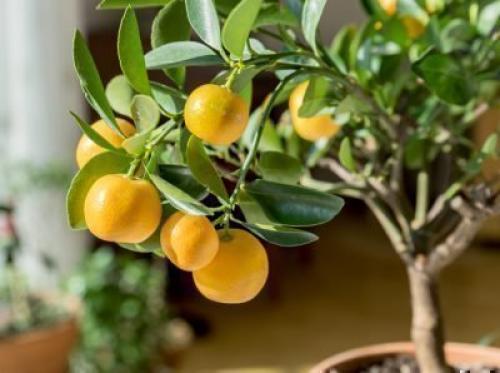

Rootstock selection
Rootstock is a plant onto which a bud or stalk (scion) of a fruit-bearing tree is grafted. The type of rootstock does not matter. You can successfully graft an orange, tangerine, or grapefruit onto a lemon.
The thickness of the stem of the rootstock is also not important, but for convenience it is better if it is the size of a pencil. This will facilitate the procedure itself. Citrus fruits can also be grafted on thinner branches - from 3 mm in diameter. The height and location of the vaccination does not matter.
General rules
In order to successfully plant citrus fruits and get a fruiting plant in the future, several important rules should be taken into account:
- A sharp object is required for manipulation. They will need to cut off the grafting material. For this purpose, a medical scalpel, blade, stationery knife, or a special machine is suitable.
- Before cutting the graft, the stem of the cultivated plant should be wiped with a dry cloth to remove any residual dust.In order to disinfect, it is necessary to wipe the central conductor of the rootstock at the grafting site.
- Before starting the manipulation, you should cut off the unnecessary shoot from the rootstock plant. If the bark leaves this branch easily, the survival rate of the kidney will be high. The bark does not come off well - you need to wait for new shoots to grow and make another test.
- The thickness of the rootstock and the scion should be approximately the same. In case of mismatch, it is necessary to combine their bark as much as possible at least in one place.
- Adhesive tape is required to fix the scion to the rootstock. The most convenient and effective material that does not allow moisture and air to pass through is latex. You can use regular medical gloves cut into strips.
- Using such a strapping material, you will not need to cover the plant with glass or a bottle to protect it from sudden changes in temperature and fluctuations in humidity.
Watering and replanting
Mandarin is no less anxious about humidity. In the summer months, it should be watered abundantly without flooding, while in the winter the water supply should be reduced, periodically making sure that the soil does not dry out. In addition, it is necessary to spray the leaves daily, using filtered or boiled clean water for this purpose. You can compensate for the dryness of the air by placing a small decorative indoor fountain next to the tangerine. As it grows, the tree needs to be transplanted into larger pots periodically. It is best to carry out the movement in early spring. In this case, the new pot should have a diameter of three to five centimeters larger than the previous one.
Other close relatives of citrus fruits are Kumquat and Calamondin. Lovers of original indoor plants should definitely get these types of plants.
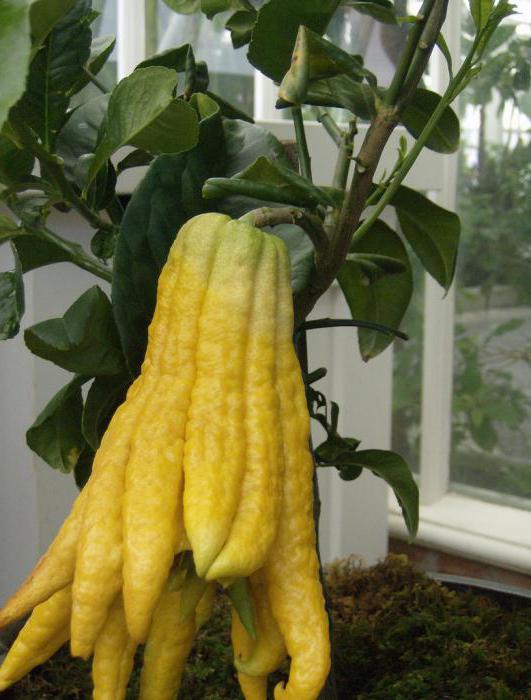

Speaking of exotics, one should definitely mention the Buddha Hand variety. This citrus is distinguished by the unusual appearance of its fruit: it resembles a lemon in color, and outwardly - a fleshy brush on the hand. However, there is no edible pulp inside. Nevertheless, the fruit is so exotic that it should definitely be grown at home.
You can rarely see a fruiting lemon, tangerine or orange tree in an ordinary apartment. Many people think that citruses are capricious and require too complicated care at home. This is not entirely true. There are specially bred modern varieties of citrus plants that are adapted for growing in a city apartment. From small bushes, you can even harvest fragrant and, truly, fresh fruits.
Types of indoor citrus fruits
In the conditions of apartments, there is often a lack of light. The most shade-tolerant representatives of the citrus family are citron and lemon. They are most commonly grown at home. In addition to these crops, you can see other plants that love the sun on the windowsills:
- mandarin;
- fortunella;
- grapefruit;
- pomelo.
Some citrus fruits tend to grow unevenly. For some time they are actively developing, then a period of dormancy begins: all processes are suspended, the wood matures. After that, the plant begins to form new shoots and leaves again.
Often these crops bloom and bear fruit several times a year. The flowers are bisexual, self-pollinating in many species. To promote the formation of ovaries, they use the technique of artificial pollination with a brush. The fruits ripen for 5-9 months.
Citrus trees at home look especially impressive during flowering, when they already have fruit. Cultures are kept in a winter garden or on a windowsill.
Description
Citrus or Citrus (lat.) Is a genus of trees or shrubs that preserve greenery all year round. Citrus fruits belong to the Pomerances subfamily, their homeland is the tropics and subtropics of Southeast Asia.
Under natural conditions, citrus fruits can reach a height of ten meters. These are trees or shrubs with thorny bark.The foliage has a juicy green hue, it is smooth and shiny, and contains many essential oils.
Indoor citrus plants bloom twice a year, white or pinkish flowers, exuding a refreshing pleasant aroma.
Homemade citrus fruits do not have the harsh acidity of the "street" plant, they are more pleasant to the taste. In terms of the presence of vitamins and other useful substances, they are not inferior to fruits bought in the store.
Interesting
... Some citrus indoor plants can bloom and pour fruit at the same time. The bush, strewn with snow-white flowers and golden or orange fruits, looks very impressive.
Types of citrus fruits suitable for growing at home
Description of citrus fruits as houseplants
The place for growing citrus indoor plants should not be on the windowsill from the north of the house, near a microwave oven, in drafts, and near central heating batteries or other heating appliances. Citrus fruits belong to shade-tolerant crops, therefore it is more favorable to place them on the east or west window, but it is also possible at a short distance from the southern window sill.
Temperature
For plants, places where warm and cold air is found, as well as elevated air temperatures, are dangerous. In the presence of at least one of these unfavorable moments, the leaves on citrus fruits begin to fall off.
In the period from November to February, when the crops are in a dormant period, a special maintenance regime is introduced - low air temperature in the room, the absence of any water procedures (spraying and watering) and top dressing.
Air humidity
The humidity level should be high. It can be maintained with the help of daily spraying, the water temperature should not be lower than 25 degrees. Overdried indoor air is painfully tolerated by citrus plants.
It is not recommended to use tap water for irrigation, the presence of chlorine in it will negatively affect indoor pets. Irrigation water (with a temperature of 20-22 degrees) should be settled and slightly acidified. To do this, add a few drops of vinegar to it.
Pot selection
The ideal pot material is unglazed fired clay or wood. There must be drainage holes and a good drainage layer at the bottom of the flower container.
Indoor citrus fruits will fully develop only in a special substrate for this type of plant. It is recommended to purchase a high-quality soil mixture only in specialized shops for flower growers, so that its quality is not in doubt.
It is necessary to feed exotic citrus plants regularly from February to November. You can use organic fertilizers or mineral fertilizers containing nitrogen, potassium and phosphorus.
The first step towards growing a citrus houseplant is choosing a species, the properties and features of which are optimal for a particular owner. To do this, you need to find out which ones are suitable for the home.
The variety belongs to one of the genera of the citrus group - flowering woody plants of the Rutaceae family. This genus includes a number of species: orange, tangerine, lemon, grapefruit, etc. They include a large number of subspecies and hybrid forms. Many of them are ornamental and are often grown as indoor plants.
The peculiarity and value of these common garden trees is that they give special berry-like fruits - hesperidium or orange. This fruit consists of a layered hard shell, which is filled with lobules of juicy, nutritious mass with seeds inside.
The flowering time of citrus plants is from mid to late spring. Specific dates depend on the variety. Fruiting begins in mid-spring and ends in winter.
In nature, there are enough citrus species suitable for home cultivation. Among them are familiar, classic species and representatives of rare, exotic plants.
Indoor citrus fruits that can be grown in an apartment:
- Lemon.
- Mandarin.
- Trifoliate or three-leaf poncirus is a small shrub with a tent-shaped crown. Fruits are inedible, from 4 to 6 cm, golden yellow in color. The peculiarity of tripolyate is that it is one of the most cold-resistant representatives of citrus plants and tolerates temperatures as low as –18-20 ° C. The poncirus is resistant to hybrid diseases. It is actively used as a decorative rootstock (a plant on which another variety is grafted) for other citrus fruits.
- Orange.
- Grapefruit.
- Pomelo.
- Kumquat, also fortunella or kinkan. The fruit is round, elongated up to 3 cm, golden yellow. Hesperidium is edible, taste - sweet rind, pulp with a slight sourness. Weak root system, which is often leveled by grafting. A popular indoor citrus plant.
- Calamondin or citrofortunella is a fast growing and well branching tree. It is a hybrid of mandarin and kumquat. A compact plant with a compact crown and a pleasant smell. The flowers and rind of the fruit have a strong aroma. The fruit resembles small tangerines. Great as a homemade citrus tree. Tolerates both cool and warm conditions. In summer, it feels good on the balcony. Calamondin will decorate the house, especially during the period of simultaneous fruit ripening and flowering.
- Finger citron. Differs in amazing fruits that have the shape of multiple dissected fingers. Because of this feature, the citron received the nickname "Buddha's hand". There is practically no pulp in the fruit. A fairly large tree or shrub for the house, up to 4 m high. The crown has spreading branches with rare thorns. The flowering period is mid-spring, fruiting is from mid-autumn to early winter. The flowers have a scent. The tree and its fruits in the East are considered messengers of happiness, good luck, wealth, longevity and prosperity. The fruits are inedible, but when dried they are used as a seasoning.
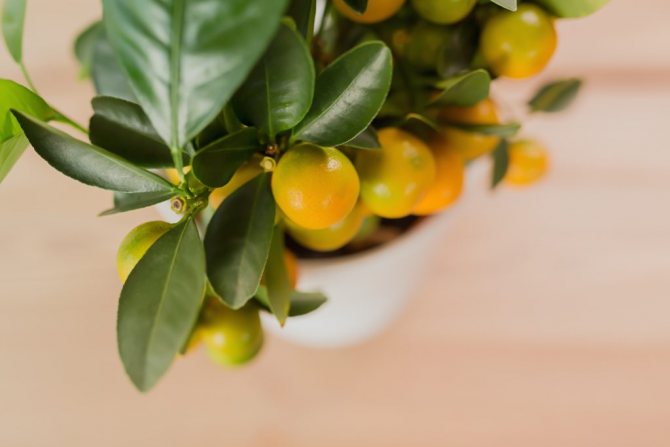

Growing beautiful and healthy citrus fruits at home requires the challenges of caring for and maintaining a supportive atmosphere. These heat-loving plants are susceptible to various diseases and ailments, they have enemies in the form of pests. When growing citrus fruits, you need to take care of protection from diseases and insects, timely prevention and treatment.
Hommosis or gum flow is a painful lesion, expressed in the appearance of a viscous and sticky liquid on the bark and roots of a plant. It destroys the structure of the wood, which affects the movement of fluids. Causes of gum flow are poor growing conditions (lack of drainage in the soil, deep planting of the plant), other diseases or insects, lack of potassium and phosphorus with an excess of nitrogen.
Anthractosis is a fungal disease that affects fruits, leaves and branches. The disease manifests itself in the form of dark spots and ulcers. Affected leaves turn yellow, dry up and fall off. The fruits of a diseased tree rot. The fungus is transmitted through soil, plant organic debris. Citrus fruits get sick due to improper care, high humidity. For treatment, special fungicides are used, and all affected areas are removed.
Wart is a fungal infection of all parts of the plant. It begins with the appearance of small yellow spots, which develop into pinkish-gray wart growths. Development conditions are high humidity and temperature. The affected branches die, the fruits fall prematurely.
Cancer is an incurable disease caused by bacteria. It affects leaves and fruits. It appears as dark brown spots of bright shades. The plant must be destroyed. The primer is also no longer used.Late blight is a fungal disease of plants. Expressed in the formation of brownish oil spots.
It is necessary to carry out preventive and strengthening measures (transplantation, pruning, treatment with means, top dressing, soil renewal), monitor the temperature, humidity and light conditions.
You can rarely see a fruiting lemon, tangerine or orange tree in an ordinary apartment. Many people think that citruses are capricious and require too complicated care at home. This is not entirely true. There are specially bred modern varieties of citrus plants that are adapted for growing in a city apartment. From small bushes, you can even harvest fragrant and, truly, fresh fruits.
Citrus
Description
Citrus or Citrus (lat.) Is a genus of trees or shrubs that preserve greenery all year round. Citrus fruits belong to the Pomerances subfamily, their homeland is the tropics and subtropics of Southeast Asia.
Read more: Lemon Tashkent - Sam-Village
Under natural conditions, citrus fruits can reach a height of ten meters. These are trees or shrubs with bark covered with thorns. The foliage has a juicy green hue, it is smooth and shiny, and contains many essential oils.
Indoor citrus plants bloom twice a year, white or pinkish flowers, exuding a refreshing pleasant aroma.
Interesting. Some citrus indoor plants can bloom and pour fruit at the same time. The bush, strewn with snow-white flowers and golden or orange fruits, looks very impressive.
- Lemon (Citron) is the most common of the genus found in the pot culture. The varietal lemon is early ripening, has a compact size (about 120 - 150 cm) and is not capricious in the course. The largest fruits (weighing up to 1 kg) are possessed by the Ponderosa lemon. The variety can bloom more than twice a year, several large lemons ripen on one bush, with a lumpy, spongy skin.
It begins to bear fruit at 6 years old. A bountiful harvest can be harvested from the Meyer lemon bush. The harvest begins to form in the fourth year of life, the fruits have a slight pleasant bitterness. Pavlovsky lemon is an old Russian early-ripening variety, the harvest from which can be harvested 3 years after sowing.The fruit of the lemon Buddha's Hand looks very unusual, it looks like a human hand with long fingers, although some see it in the form of a golden octopus fruit.
Lemon
- Indoor tangerine (unshiu) is inferior in fruit size to lemon, but surpasses it in yield. A small tree (up to 130 - 140 cm) is densely covered with round orange mandarins, which have no seeds at all. They are juicy, odorous and very sweet.
Mandarin - Orange. It will take almost 9 months to wait for its fruits to ripen. The long wait is rewarded with a wonderful fresh taste.
Orange - Kumquat or fortunella. The plant resembles a dwarf orange in appearance, but its fruits are cylindrical in shape. There is a variegated variety of kumquat "Variegata" with white or yellowish stripes on the leaves.
Kumquat - Calamondin (citrofortunella) is a decorative hybrid of mandarin and fortunella, reaching a height of 100 cm. The bush is covered with dark green shiny small greens and a lot of bitter and small (3-4 cm in diameter) orange "balls".
Calamondin
Location
The soil
The soil for citrus plants should show a neutral or slightly acidic reaction, be breathable and nutritious. In the store you can buy ready-made soil "Lemon" that meets all the requirements.
For the self-made preparation of the substrate, mix in equal proportions of high-moor peat, sod oak or field clover soil, sand, well-rotted manure, with the addition of wood ash. The land must be disinfected from weed seeds and pest larvae by roasting over a fire or in the oven, steaming in a water bath.
A citrus pot is chosen wide, medium in height. It is better to take a ceramic, heavy pot so that it is stable and does not turn over. The presence of holes in the bottom for the drain of excess water is required.
How to grow a tangerine
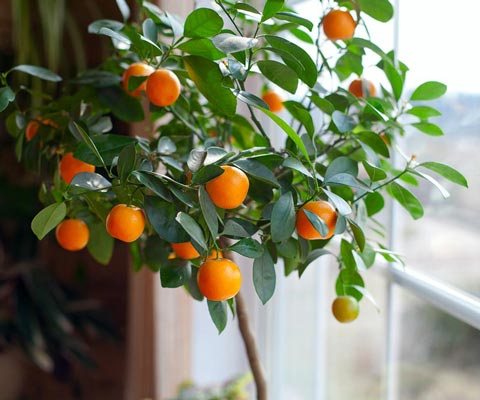

Mandarin, like lemon, requires regular transplanting in the spring. In addition, it is more thermophilic and picky about the level of humidity. It is better not to keep home tangerine at temperatures below 20 degrees, otherwise the plant will quickly die. However, a clear advantage of the species is its faster period of entry into fruiting - within 5–6 years, the development of fruits is possible.
Mandarin, in addition to the requirements for lighting and moisture, also needs regular feeding and treatment from pests. Unfortunately, these plants are very susceptible to aphids, spider mites and mealybugs. Also, the problem of mandarin is the complexity of the flowering process, which often needs stimulation.
We often talk about the benefits of indoor plants: they not only decorate the interior, but also create a healthy indoor microclimate, effectively purifying and humidifying the air. Someone likes to grow phalaenopsis and other orchids, someone loves violets and azaleas, and some create a real mini-vegetable garden in the kitchen.
These wonderful subtropical plants feel great in city apartments, their small white flowers spread a delicious and very strong aroma, shiny leaves release useful essential oils and phytoncides into the air, and fruits collected on their own windowsill have all the useful properties of ordinary citrus fruits.
Fortunella, tangerines, lemons and oranges are often grown at home. Some keen enthusiasts even try to grow grapefruits, sweets and pomelos.
However, from a purely practical point of view, it is still advisable to choose a type of citrus with small fruits, so that a small indoor tree can easily support their weight. Therefore, sweet varieties of tangerines, fortunella, lemons and limes are quite suitable for growing at home.
The easiest way to get indoor citrus is to buy a ready-made tree. Beautiful citrus plants from Dutch nurseries, which are sold in flower shops already with fruits, are most often tangerines (with larger rounded fruits) and fortunella (with small elongated fruits).
If everyone knows everything about tangerines, then fortunella (or kumquat) should be told separately, because this wonderful type of citrus is worth paying attention to.
In nature, fortunella grows in the subtropics of Asia, however, due to a number of useful properties, it has gained immense popularity in agriculture in southern Europe, Australia and the southern states of the United States. For example, they are very fond of growing it in Greece and Montenegro. Due to its compact size, decorativeness, rapid growth and fruiting, fortunella has also become a very popular indoor plant - of all citrus fruits, it is the most convenient and profitable to grow at home.
Fortunella is usually sold in flower centers as neat shrubs and small trees completely covered in small fruits that are a treasure trove of healthy vitamins, minerals and antioxidants.
In addition to fresh consumption, the fruits of fortunella are wonderfully processed: sweet candied fruits, delicious jam and marmalade, aromatic liqueurs are made from them.
Many people try to grow citrus fruits by planting a seed from the fruit they like in a pot with moist soil. As a rule, a strong sprout emerges from the ground very quickly, which in several years develops into a beautiful harmonious tree.
Its neat trunk and beautiful crown with shiny leaves are always pleasing to the eye, and observing the active growth of an exotic tree is a real pleasure.
If you do not expect flowering and fruiting from your indoor pet, then growing a citrus tree from a seed, forming its crown, or even giving it the shape of a trunk, is a very exciting and exciting hobby.
The wild citrus fruits enter the fruiting season very late and their fruits are unsuitable for food because of the bitter taste. Therefore, in order to obtain fruit on a tree grown from a stone, it is necessary to inoculate a varietal branch from a fruiting tree, which will develop over time into a fruiting plant.
You can find a sprig for grafting on the forums of plant lovers, in agricultural institutes and greenhouses.
There is another rather adventurous way to get material for grafting - to bring fresh twigs from a vacation in a warm country. It is very important to taste the fruit from the tree from which you intend to sprout, because there are usually many wild birds growing on the streets with bitter fruits.
The twigs need to be cut literally before departure, carefully wrapped in a damp cloth and in a plastic bag, and, having arrived home, the first thing to do is to graft them on your tree.
For reliability, it is better to do more than one vaccination, but several at once - this way you increase the chances that at least one of the varietal branches will take root.
Branches of varietal fruiting citrus fruits can be used not only for grafting, but also as cuttings: root them in a glass of water or in the ground under a plastic bag - and you will get a young plant that has completely inherited all the varietal characteristics of its parents. Cuttings are obtained in the same ways that we talked about above: on forums of plant lovers, in agricultural institutes, or are brought from southern countries.
These plants are completely undemanding to keeping conditions. For the full development of a tree, it needs a pot of sufficient size, but you should not immediately plant a tiny sprout in a huge container: it is much more useful to transplant the plant into larger containers as it grows. For planting, it is most convenient to use ready-made citrus soil, or lemon soil, which are often sold in flower shops.
It is very important to take care of good drainage so that water does not accumulate at the roots and the plant does not get sick. To do this, there must be a sufficient number of drainage holes in the pot, and when planting, a layer of pebbles or expanded clay should be poured onto the bottom so that excess water quickly leaves through it.
Citruses are very fond of bright, sunny places and regular watering, which is slightly reduced in the winter months. During the period of active growth, they are periodically fed with liquid mineral fertilizers diluted according to the instructions.
In summer, it is very useful to take the tree out to the balcony or even take it to the country house so that it grows stronger under the sun in the open air.
Quartblog digest
5 Luxurious Balcony Decorating Flowers - How to create a beautiful corner of wildlife on a city balcony? Today we will tell you how easy it is to decorate a balcony with unpretentious flowering plants.
Blooming Decoration - Usambara Violet (Saintpaulia) - Modern varieties of indoor violets can look amazing and bloom almost continuously with very simple care. We will tell you in detail about the beautiful uzambar violet and caring for it at home.
To know and be able to: forcing bulbous plants at home - Forcing, that is, artificial stimulation of the accelerated growth and development of the bulb of bulbous plants at home: we will tell you about 3 simple ways.
Read next: Coconut tree how to plant a houseplant at home
7 aromatic herbs that purify the air in the apartment - Double benefit: air purification and healing aromas: grass in the apartment as a source of pure oxygen
Several types of citrus can be grown at home. The most famous among them are lemon, orange and tangerine trees.They take root quite easily, grow well and look spectacular throughout flowering.
After the juicy fruits of this citrus bought in the store are eaten, the remaining seeds can be used as planting material. For the greatest probability of success of the event, it is better to have more seeds, since definitely not all will germinate. Therefore, to obtain seedlings, you need to take a dozen seeds.
The planting material is placed in cheesecloth for several days and slightly moistened. This is necessary so that the bones, swelling, "hatch".
Tangerines can be grown at home in special citrus soil purchased at a flower shop. Although, in principle, almost any light soil is suitable for this culture. For example, in mixed in equal proportions turf and leafy soil, to which compost and rotted manure humus will be added, the tangerine will be very comfortable.
Mandarin is a tree that grows rather slowly at home, and it sometimes stops its growth. Therefore, you should not lose hope and enthusiasm, because when this citrus is provided with all the necessary conditions, it grows into a very beautiful tree.
According to agronomists, tangerine is a very unpretentious tree to maintain, not only among citrus fruits, but also among many other plants, but it still requires observance of certain rules when leaving. The most important condition for him is the abundance of sunlight. Mandarin requires intense lighting up to twelve hours a day all year round.
Care
The main difficulty in caring for all citrus plants is providing them with a dormant period in winter with low air temperatures. Only orange needs warmth (13 - 16 degrees), other species are kept at + 5 + 9 degrees. The lighting should still be bright, so you won't be able to remove the flower in a cool pantry. Watering in winter is reduced to once a decade, keeping the substrate only barely moist.
Important
! Excessive moisture, combined with a low temperature, will lead to decay of the roots of the plant.
Watering indoor citruses, during the active growing season, needs regular, but not excessive. Stagnation of water in the sump must not be allowed. The water should be at room temperature, not chlorinated or hard. Rain or snow moisture works well.
Citrons need an air humidity of 70%. This level is achieved by regular (daily in summer) spraying in the evening. You can put wide bowls of water near the plants, in which expanded clay is poured. The evaporating moisture will soften the dry air in the apartment.
Lemons, oranges and other members of the genus need regular feeding from February to October. Liquid solutions of mineral fertilizers for citrus fruits alternate with infusions of mullein or bird guano in a weak concentration (1 to 10 and 1 to 20, respectively). The frequency of fertilization is once every 15 days.
Important
! Top dressing is carried out only on wet soil, in order to avoid scalding the roots. Citrus fruits respond well to watering the soil with Baikal, whose composition enriches the soil with beneficial bacteria.
Pruning a plant has not only a decorative function, but also affects the yield. Cutting the crown of citrus fruits is carried out in February, before the plants wake up from sleep, and in the summer, shortening the fattening shoots. Different types have small pruning features:
- an orange needs a pinch of the main stem, as it tends to grow upward;
- tangerine forms many lateral shoots, which are cut out to thin out the crown;
- kumquat and calamondin almost do not require shaping;
- lemon is difficult to form, cut it carefully, shortening only the shoots that have borne fruit.
The formation of young citruses begins as early as possible, avoiding thickening of the crown.
Diseases and pests
If mistakes are made in the care of indoor citrus plants, they begin to hurt or are exposed to the invasion of such pests:
- mealybug;
- shield;
- whitefly;
- aphid;
- spider mite.
It is worth regularly inspecting trees for the presence of insects, as well as for signs of their parasitism:
- sweet discharge;
- yellow dots on the leaves, below - powdery bloom;
- white lumps in sinuses, trunks and shoots.
To combat pests, plants are regularly washed under the shower. It is also worth taking proper care of them: watering moderately, adjusting the temperature and humidity of the air.
Insects are removed with a wet wipe or ash and soap solution. In extreme cases, use a drug called "Aktara" (1 g per 10 liters).
Fungal diseases rarely affect citrus fruits when kept in the house. This happens more often in greenhouses. In indoor conditions, fruit trees are affected by a sooty fungus, which appears as a result of the sweet secretions of insects.
Viral diseases such as mosaic cannot be cured.
Pets can also harm trees.
Reproduction
Citrus fruits grown from seeds will begin to bear fruit only 10 years or more after planting. Beautiful decorative trees can be formed from them. Experienced growers graft varietal cuttings on seed seedlings, the resulting plant has a seedling unpretentiousness and early maturity and productivity inherent in the selected variety.
Fresh seeds germinate quickly, sown in a loose peat-sandy-humus substrate, at a temperature of +25 degrees. Caring for seedlings is not difficult and does not differ much from caring for adult plants.
The most popular method for propagating citrus fruits is cuttings. Green sprigs of citrus are cut from plants in winter when they sleep. At least 3 internodes are left on the handle, the lower cut is made oblique, the bark above it is scratched with a clean knife to stimulate root formation. The tip of the branch is dusted with root or heteroauxin. One lower one is removed, the upper leaves are cut in half of the leaf plate.
The stalk is planted in a steamed wet substrate from a mixture of sand and peat. A greenhouse is built on top of the plantings. Rooting takes place in bright diffused light and a temperature of +25 degrees. Every day the cuttings are ventilated and sprayed with warm water. After 50 - 60 days, a good beard of roots is formed on the seedlings, they can be transplanted into ordinary soil and looked after as an adult plant.
Citrus pests
Scabbards: it is not difficult to detect this pest, scabbards are clearly visible on citrus fruits, but they bring significant harm - spreading throughout the tree, their brown shields stick around the stems, petioles, leaves. If you run your fingernail over the flap, a damp spot remains. In a microscope, these pests are similar in shape, excuse the comparison, to fascist helmets, shaggy from the inside, and just as nasty: they suck out cell sap, the leaves lose their color, dry and fall off.
Control measures: if your citrus tree is small, it is better to take it to the bathroom and wash the stems and leaves with a soapy sponge. If a large tree is in a bucket or tub, wipe all accessible areas with a cotton pad moistened with alcohol.
Now we need the Aktara insecticide (or confidor), it is effective against any worms, including scale insects. It is necessary to dilute the drug according to the instructions and pour a lemon or orange under the root, and then spray thoroughly over the leaves. Repeat the treatment a week later.
Other insecticides are also produced against scale insects and other insect pests: actellik, fitoverm, karbofos, decis and others. But they are more smelly, toxic and highly undesirable to use them at home.
Spider mites are one of the nastiest and most common pests on citrus fruits. Ticks are dangerous because:
- multiply and develop rapidly
- it is extremely difficult to wash them off - they hide in the axils of the leaves, in the buds, in the upper layers of the soil
- ordinary insecticides are not effective against them, but only special preparations - acaricides
- after two treatments, resistance is formed in ticks - the new generation is more resistant to the active substance of the drug.
Signs of mites on citrus fruits
- yellowish or whitish spots on the leaves without clear boundaries
- streaks and dots are gray or silvery, especially visible on young leaves
- deformed flower petals, young leaves, shriveled buds
- on the back of the leaves there are small grains, crumbs, husks - the pests themselves and skins from molting
- at high magnification (magnifying glass, microscope), the thinnest cobweb is visible.
Therefore, if you have ticks at least once, you will have to observe and observe and periodically, at least once a month, carefully examine the entire plant.
Control measures. First, wash off or wipe off the pests by hand. To do this, you will either have to take the pot to the bathroom or shower, put the pot on its side so that the leaves are in weight, and water with a powerful pressure of a hot shower; or wash each leaf by hand - take it and wipe it on both sides.
The problem is that there are no systemic drugs against ticks - so that you water it - and the ticks die. Only intestinal contact: sprayed, took out a tick. Where the solution does not get, the mites will survive and continue to multiply.
Against ticks, it is worth trying remedies such as Apallo, Vermitek, Oberon, etc.
Read more about pests of indoor plants in the section "pests"
In the culture of plant growing, citrus fruits remain the most popular among fruitful plants. In these plants everything is attractive: tough, wax-covered leaves, and fragrant spring flowering, and no less fragrant fruiting in autumn and winter. In home growing among citrus fruits, the most common are Lemon, Pomeranets, Clementine, Citron. The latter, by the way, is known for its original fruits, which are used in confectionery production, but are not eaten raw.
Oranges or lemons growing in pots is quite real if you know about all the intricacies of caring for these subtropical plants. Moreover, with the right content, you can even get fruits on a regular basis.
In addition to natural species, today you can buy various cultivars and hybrids. Among them, for example, compact (Citrus Limon Mejer), famous for its sweetish taste of fruits that appear throughout the year. Interesting and (Fortunella japonica), which looks like a small tree, whose fruits can be eaten directly with the peel.
Citrus fruits can be grown from seeds if desired. But this method is suitable for the most patient growers, besides, there is a risk of not waiting for flowering and, accordingly, fruiting.ON THE PICTURE:
Citron (Citrus medica
)
Partners
In home floriculture, planting indoor citrus plants with other flowers in one container is not practiced. But, when arranging a green corner of the tropical forest, lemons, oranges, tangerines will perfectly fit into the composition. They look harmoniously next to ficuses, ivy, roses and jasmine.
Watch also the video
TOHow to care for indoor citrus plants?
Citrus plants such as lemon, orange, grapefruit, tangerine, kink are often grown indoors. Citrus trees will only produce fruit if they are grafted, although most often they are not grown because of the fruit. Someone is just wondering whether it will be possible to grow a Mediterranean tree from a seed, while someone is delighted with the delicate aroma that the leaves exude.
In any case, in order for a citrus plant to look good, you need to know and follow some of the conditions for its maintenance, given that the care of citrus indoor plants varies depending on the season.
Lighting and air temperature
Citrus crops are native to Southeast Asia, where the weather is humid and warm and there is plenty of sunshine.Therefore, when growing citrus plants in indoor conditions, you need to select well-lit places for them. The exception is lemon, which also feels great in a shaded room.
If a citrus plant is kept at very low or very high ambient temperatures, then it cannot develop normally. In summer, the optimal temperature will be from +18 to +27 ° C, in winter it should be cooler - not higher than +12 ° C. Compliance with the temperature regime is a prerequisite for obtaining fruits.
In the spring, when the frost stops, potted plants are put outside, but not planted in the ground in order to prevent hypothermia of the roots.
During growth, citrus fruits should be sprayed with warm water every day.
How to water citrus fruits?
The trees are watered 1-2 times a week with warm water; in summer, watering should be abundant, and in winter moderate.
As the growth cycle slows down in winter, the plant needs less water. To prevent the tree from dying from an excess of moisture, watering is reduced since October. But overdrying of the earthen coma should not be allowed, so that leaves and fruits do not fall off.
There is another important point to pay attention to during the winter months: the temperature of the earth must be at least + 18 ° C. To prevent a drop in temperature, watering must be done only with warm water.
Citrus transplant
Young trees should be replanted only by transshipment. Moreover, the transplant must be carried out in a timely manner, because due to a lack of nutrients, the plant will not be able to develop normally.
If the roots of the tree did not have time to cover the entire earthen lump, there is no need to transship, it will be enough to replace the drainage and the topsoil.
Before transshipment, be sure to treat the pot with a solution of potassium permanganate or scald it with boiling water.
Trees that are already bearing fruit are transplanted every 2-3 years, and only before the start of growth. After a period of growth, it is better not to touch the plant. Also, you do not need to transplant a plant with flowers or fruits, as this will lead to their falling off.
For citrus young plants, the mixture is made light: one part of leafy soil, sand and humus from cow dung and two parts of sod land. For adult plants, a heavier mixture is needed: one part each of leafy soil, sand and humus, three parts of sod land and a little non-greasy clay.
How to fertilize citrus fruits?
Thanks to fertilizers, the sugar content of the fruits increases and their bitter taste decreases.
Fertilize citrus fruits only when they are actively growing: from February to September. During the preparation for the rest period and during the exit from it, the concentration of fertilizers should be halved. It is best to use organic fertilizers (bird droppings, slurry of cow dung), combined mineral fertilizers, or fertilizers specifically designed for citrus crops.
It is very important to know that underfeeding is better than overfeeding a plant. With a lack of nutrition, timely feeding can be carried out, while an excess of fertilizer leads to root burns and even the death of the plant. The most important sign of an overabundance of fertilizers is the appearance of a dry border along the edge of the leaves and their fall.
If the foliage is crumbling heavily, then it is impossible to feed the tree, since untimely feeding can do him a lot of harm.
The orange tree is. It can be propagated by cuttings, grafting or seeds. If you wanted to grow this yourself, then it is better to choose the seed method, since it is the easiest of all.
This article will discuss how to grow an orange from a seed in a pot at home.
Breeding
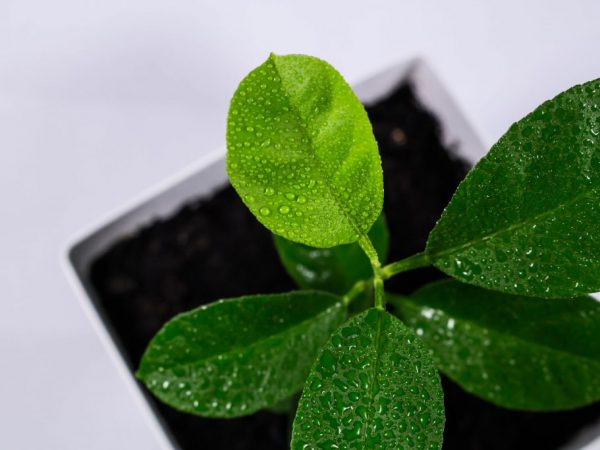

The best way to propagate is by cuttings.
There are several ways to propagate a homemade citrus tree.So that attempts to grow a new ornamental plant are not unsuccessful, you need to know all the subtleties of the process.
From the bone
The seeds are extracted from ripe or slightly overripe citrus. They are planted immediately in a pot with drainage, without drying. The soil mixture should contain leafy soil, coarse sand and fertile soil. The bones are sealed to a depth of 2-3 cm. The pot is covered with a plastic bag. Placed on a windowsill so that the sun falls on it. The film is regularly removed for airing.
The seeds are watered every 3 days. In winter, the greenhouse is illuminated. Seedlings appear in about a month. The timing depends on the quality of the seeds, lighting and room temperature.
Cuttings
Cutting is the best way to propagate citrus fruits at home. Cuttings are cut from healthy mature plants when they are dormant. Each twig should have 2-3 buds and a length of about 10 cm. For spring cuttings, branches of autumn growth are taken, for summer - spring ones.
The procedure is performed step by step:
- make the top cut, it should be straight;
- the second is oblique, it is produced under the bud of the lower leaf, which is removed;
- slightly scratch the bark with a needle;
- placed for some time in a root solution;
- planted in the ground, deepening to the first leaf.
Rooting cuttings is best done in a sterile mixture of peat and sand. The ambient temperature should be 25 ° C. Provide diffused light. The process lasts from 2 weeks to 2 months. Propagated by cuttings, citrus fruits develop well and bloom quickly.
Graft
The method is more often used to obtain new plants on an industrial scale, since it requires special knowledge. At home, a method is used for breeding capricious variegated species. The grafted plant inherits the desired qualities. This method also propagates crops that have a poorly developed root system. Grafting on a strong rootstock provides them with good roots.
general information
The tree has a dense, compact crown. Leaves are bright green and dense. The branches are covered with light bark. It blooms with white, light flowers. Indoor orange bears fruit after 7 years of life. The fruits can be eaten as they are very tasty.
Did you know?
There are about 600 varieties of oranges in the world.
The height of the plant depends on the variety and can reach 1-2.5 m. Before growing an orange at home, you need to decide on the variety.
The most popular are:
It is quite possible to grow an orange from a seed at home. Let's consider how to do this so that it bears fruit.
Possible problems
If the care of citrus plants at home is done incorrectly, this is manifested by a deterioration in their condition. Possible problems like this:
- Sharp jumps in temperature (7 ° C-10 ° C) threaten with leaf fall.
- The difference between the temperature of the soil and the air near the crown leads to shedding of leaves.
- With too much water absorption by the roots, dropsy develops, since the ground part of the culture does not have time to consume liquid. Growths appear below the sheet plate that cannot be eliminated. This is especially true when abundant watering is combined with low temperatures.
- Improper illumination: with a lack of light, too large and green leaves are formed, a strong deficiency is manifested by yellowing and falling foliage. If the light is too intense, the leaf plates become discolored. Direct sunlight often causes burns. This is especially common after winter, when the citrus tree weaned from the sun.
- An excess of fertilizer appears as a dry border around the leaves. Their fall begins.
- Lack of nutrients: if there is not enough nitrogen, the foliage becomes dull and turns yellow. With a deficiency of phosphorus, the flowering is weak, the leaf plates lose their gloss.When citrus fruits need potassium, grooves appear on the leaves, they fold along the central veins.
Growing from seed
In order for the seeds to germinate, it is necessary to plant them correctly, observing the conditions.
Planting seeds
It is not difficult to grow an orange from a seed. Consider how to plant seeds at home. The seeds must be obtained from a ripe orange. They must be of the correct shape, not empty or dry.
They need to be cleaned of pulp, rinsed and soaked for 8-12 hours in water. The soil can be made from, sand, turf soil (1: 1: 2). Or you can buy a special one for.
You can sow seeds in separate small containers, the volume of which is about 100 ml. Or it is allowed to plant all the seeds in one box. It is recommended to keep a distance of 5 cm between seeds. The planting depth should be 1 cm.
Lemon Tree
The lemon tree is an unpretentious and persistent citrus fruit that shows good fruiting and hardiness results. In addition, lemon gets along well in low light and moisture conditions. Keep in mind, however, that the lemon tree needs regular pruning and fertilization, as a well-groomed tree will provide you with delicious and aromatic fruits.
Lemon is planted from seeds or cuttings. As already mentioned, plants from seeds will begin to bear fruit only after 10-15 years. For development, planting material is used of the varieties Pavlovsky, Maikop, Novogruzinsky - these are varieties specially created for home conditions.
Home care for this type of citrus crop is not very different from the growing conditions for tangerine. Both a newly acquired tree and one that has been growing in the house for many years must be transplanted every year. The best time for this is spring, when the plant is just getting ready to expend energy for growth. For young crops, regular watering and spraying is a prerequisite for a normal existence.
Citrus grafting
Grafting on the cutting
Citrus crops to obtain fruiting plants are usually propagated by grafting or rooting cuttings. The first method requires experience and skill. The second is not applicable to all plants. So, tangerines, kumquats and limes practically do not take root at all. Little
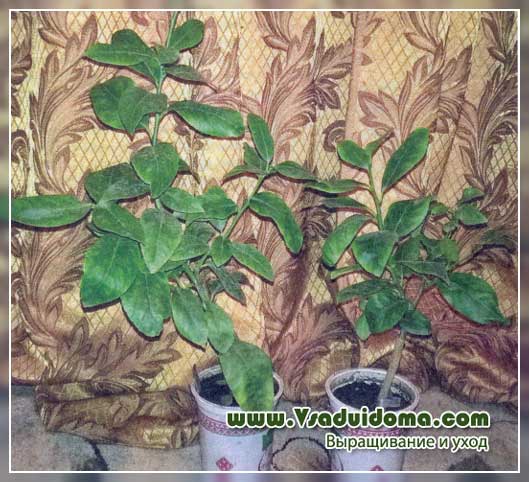

oranges and grapefruits perform better. So which is better - grafting or grafting?
Chitrus cuttings
If you are engaged in cuttings, then it is worth stopping at lemons, citrons and pomelo. They can be rooted in different substrates, I use vermiculite for this. I pre-soak the cuttings for 10-12 hours in a concentrated solution of Heteroauxin - I dilute 1 tablet in 500 ml of water. Cuttings placed for rooting from May to September take root best of all.
Vaccinations take root better and grow together in the same time frame. Here, quality material also plays an important role. The rootstock and scion must be healthy, free from obvious signs of pests and diseases. Moreover, they must be compatible with each other. My own experience shows how important this is. A year and a half ago, I ordered a Lisbon lemon by mail. The seller said that he was looking for a lemon seedling. For a long time, the plant practically did not develop.
I concluded that the problem is the incompatibility of the scion with the stock. And I decided to experiment and re-graft the Lisbon lemon into another variety - Macrophylla. especially since I just had a stock of the required diameter, obtained by cuttings. I was inoculated in the cleavage method in the spring of 2019. The fusion of the rootstock with the scion occurred very quickly, within a month. After that, the lemon actively began to grow and quickly overtook the plant from which the scion was taken. This can be clearly seen in the photograph.
Rootstock and scion
As a rootstock, both a seedling grown from seeds and an already rooted stalk, taken, for example, after the formative pruning of one or another citrus, can be used.
It is believed that the rootstock grown from seeds is the most viable, it has a powerful root system and is already adapted to the climatic conditions in which it grew. I agree with this, but only partially. After all, what if we soon need to be vaccinated? It takes a very long time to wait for a full-fledged seedling of the required diameter to grow from a seed. Therefore, in this case, you can use a rootstock from a rooted cuttings. And, in my opinion, it is no worse, and maybe even better, than a seedling.
Personally, I like to use Macrophylla lemon as a rootstock, which I specially cut into cuttings for subsequent grafting. They take root very quickly and grow the root system just as quickly. Citruses grafted on Macrophylla grow together very quickly and immediately grow.
Returning to the question posed at the beginning of the story, which is better - grafting or grafting? - I will say that I did not manage to give a definite answer. In some cases, it is more expedient to use grafting, and in others, grafting. It all depends on the individual characteristics of the plants. But the most important thing is not to be afraid to experiment, and then there will be a real opportunity to receive a fruiting citrus plant as a reward.
Plant fertilization
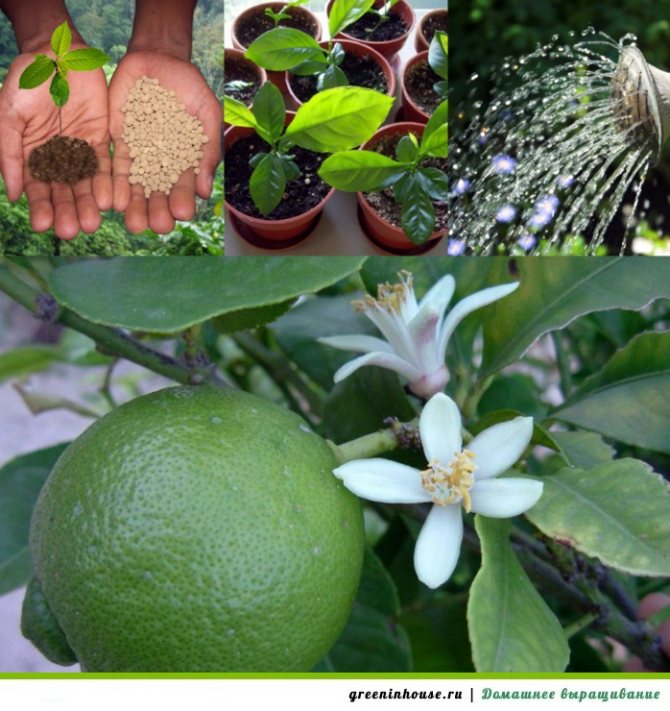

Feed the plant only during the spring and summer months when it is actively growing, but during the winter dormancy, forget about fertilizers.
First, water the soil well, and then apply top dressing. Remember that a lack of fertilizers is better than an excess of them!
If you overfeed the plant, the root system can get burned.
As a top dressing, it is better to take special fertilizers for citrus fruits, which can be easily found in specialized supermarkets.
Where to begin
For a beginner, I recommend not chasing beauty and not buying citrus fruits in flower shops, covered with a centimeter layer of wax and grown somewhere in Dutch greenhouses. The most correct way for a beginner is to grow a citrus from a seed.
For sowing, you need to have:
- a few large, freshly picked seeds of a lemon or other citrus fruit;
- a pot of unglazed fired clay with a diameter of up to 5 cm and a height of 5–7 cm with a sufficiently large drainage hole (up to 0.5–1 cm)
- a handful of expanded clay or finely broken red bricks for drainage
- a special earthy mixture for citrus fruits (available at the store)
- half a liter of room temperature water (tap water must be defended for 2-3 days to remove chlorine)
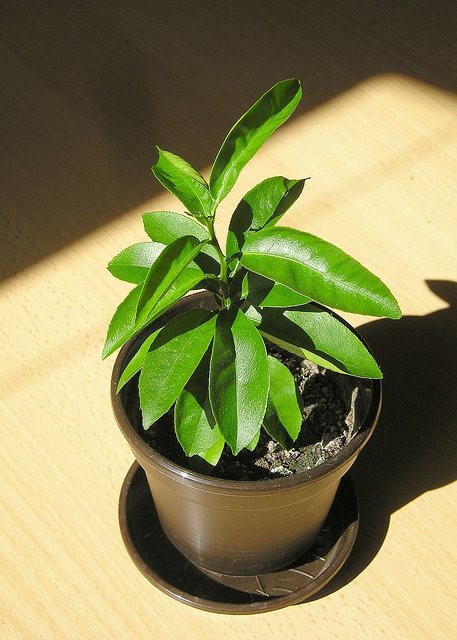

Citron seedling
Take a pot, fill it 1/5 with drainage, then pour the soil mixture into the pot, without adding about 1.5 cm to the top. Slightly compact the soil. Place the pot on a stand (pallet) and spill the pot with water until a small amount appears in the pallet. Now place the seeds on a damp soil surface in the center of the pot. Fill the pot with soil mixture (almost to the top) and place it on a light windowsill.
If watering is timely and the ambient temperature (on the windowsill) is more than 15 ° C, seedlings will appear in 3-4 weeks.
Lemon or any other plant grown from seed is called seedling
.
Calamondin
Calamondin is a citrus plant with a mandarin-like fruit appearance. However, unlike the latter, calamondin is less whimsical to light and moisture, moreover, it is very frost-resistant for a tropical plant. The tree reaches a height of 90 cm, and bears fruit all year round.
Despite the resistance to cold weather, the optimal growing temperature in summer is 21-25 degrees with a humidity of 70%, and in winter - 10-16 degrees with a humidity of 50%.This regime will provide the plant with healthy and abundant fruiting.
POT AND MIX
After you have become the proud owner of a rooted cuttings or grafted plant, be it lemon, orange, tangerine or some other citrus, the first step is to inspect the root system of the plant. If the roots have filled the entire container,
On a note
Plastic pots are very suitable for growing citrus fruits. Roots do not stick to their walls, and the plants are very easy to replant. In addition, the roots do not overheat and do not overcool, since the plastic does not conduct heat well. Plus, plastic pots are strong and durable.
I make up the earthen mixture as follows. For young plants I take 2 parts of sod land, 1 part of humus from cow or horse manure and the same amount of sand. For adult plants, everything is the same, only I take not 2, but 3 parts of sod land, you can also add a small amount of oily clay.
A few tips in the end
- Buy citrus fruits with an already formed crown. Growing from seed will take too long and the tree may not bear fruit.
- Be careful when choosing a location. The best option for citrus fruits is a warm, well-lit place with high levels of humidity.
- The dormant period is very important for the normal growth and fruiting of citrus fruits.
- Not all citrus fruits need pruning. It depends on the development of the crown and its density.
- Grafting citrus fruits can increase fruiting.
Lemon Experience
My first attempt to grow a lemon tree at home was unsuccessful, and I can't say exactly why. But I realized one thing - some citruses are capricious and not all are suitable for the same growing conditions, although, it would seem, one family, just different species, but they also have their own "troubles".
I planted the first lemon seeds simultaneously with the grapefruit seed, in the same soil, only I took a larger glass and added drainage. Otherwise, everything is the same, and the preparation of the seeds was almost the same - washing, and then briefly soaking them in a solution of epin, but I don't think that this could somehow negatively affect the seeds. I took the lemon with a thin skin and wanted to germinate its seeds precisely because of its taste, since it reminded us of the fruits of our adult lemon tree:
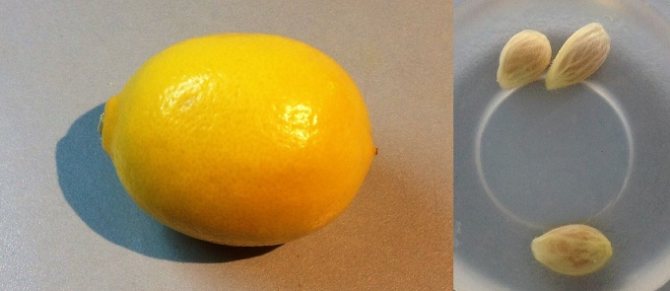

She put the bones, dug in, watered them, put them under the bag ... And after a while the soil began to grow moldy! I don't think this could have happened because of the epin, most likely that the grapefruit is good, then the lemon is not very good, so I removed the seed from the ground and observed this picture:
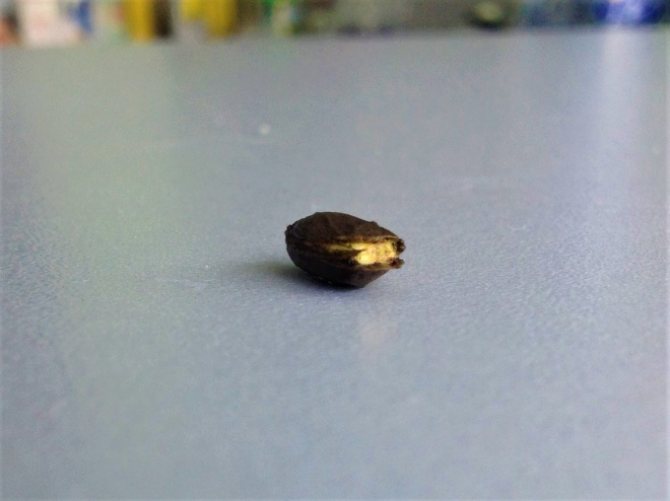

The upper shell cracked at the bone. At first I thought that the root was starting to break through, but no, it was the beginning of the decay process. After placing the seed again in the ground, after a while, it completely lost its outer seed coat, and then disintegrated into 2 parts, despite the fact that it turned very beautifully green before this decay ...
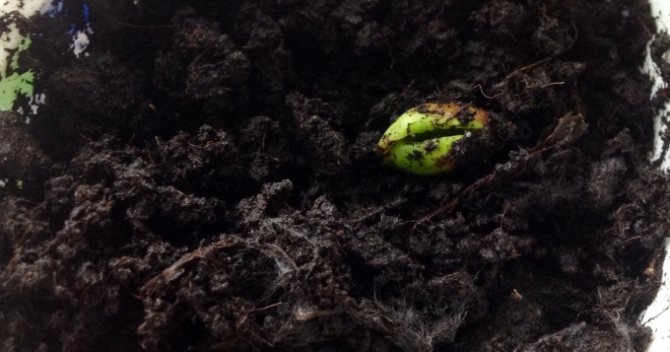

Then I made the following conclusions: since an adult lemon grows at my house, why not use his little piece of land? By its properties, it is less greasy, enriched with calcium and does not become moldy. I decided to bury a few seeds of the same lemon in his pot. But, in order not to cause even more harm to the already unfortunate lemon tree, I decided to extract the little lemons as soon as they are "born." I didn’t know the exact time of planting, but it felt like the first sprout appeared very quickly, during the first two weeks:
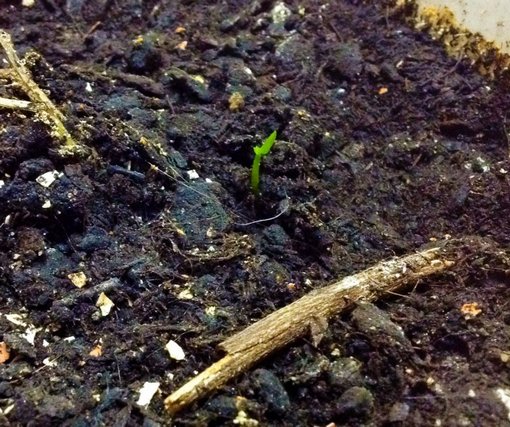

I did not soak these seeds before planting, I just washed them and stuck them in the ground. Maybe it is precisely the soaking of the lemon pits that they do not tolerate? Just such a conclusion suggests itself, since after a while the rest of the sprouts "pulled up", and a whole front garden was formed in the pot of an adult plant:
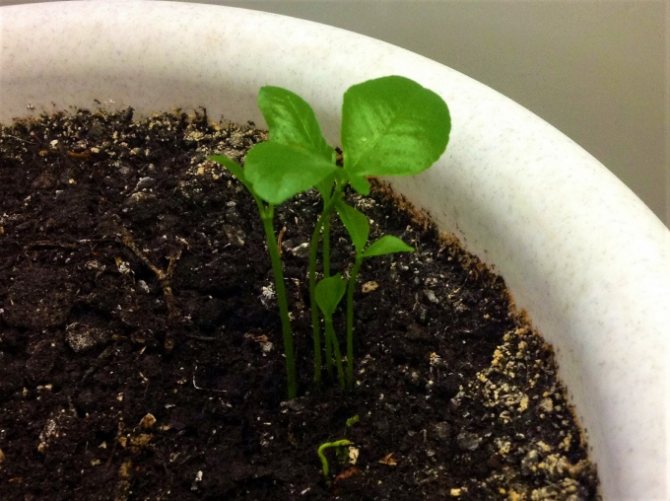

Of course, as soon as all the plants appeared from the ground, I took them out and planted them in a separate pot ... But that's a completely different story))
To vaccinate or not to vaccinate?
So, it's been 2 years. You have a seedling 40-50 cm high with a stem thickness of up to 1 cm, growing in a pot with a volume of up to 1 liter. What's next? Then it's up to you to decide. Lemon grown from seed, with proper care, begins to bear fruit at the 15-25th year, the orange and tangerine - at the 10-15th, the grapefruit - at the 3-5th. In order for your seedling to begin bearing fruit in the 2nd to 4th year, it is necessary to inoculate with a bud or cuttings from a cultivated fruiting plant. But if you compare the whimsicality of your "Spartan" grown from a seed and a grafted plant, there is a huge difference. The oculant (grafted seedling) is more demanding on the conditions of detention than your "wild". I sometimes give such an example to my customers: take a homeless dog - he sleeps where he has to, eats from time to time, snow, rain, wind - nothing for nothing, alive and alive and happy to be happy. And now let's take a pure-blooded Doberman for comparison and put him for a short time in the conditions of an unfortunate stray dog - the animal will die. So in our case, any varietal plant is more whimsical than a wild one (grown from a seed).
If the previous paragraph did not affect the person who wants to have a varietal lemon, I continue to "intimidate". Usually I ask the question: "Do you want to get yourself a baby?" Indoor varietal lemon is very whimsical. The only thing that makes him different from a baby is that he does not scream at night. If this did not frighten my listener, then I turn to explanations. The most common varieties of lemon for home cultivation are Pavlovsky, Novogruzinsky, Udarnik, Maikop, Lisbon, Kabo, Panderoza, Meyer ("Chinese dwarf"). Orange: Pavlovsky, Washington Navell. Mandarin: Pavlovsky, Unshiu, Kalamandin. Of the citrus fruits, lemon is the most demanding in terms of growing conditions: it does not tolerate drafts, changes in temperature, watering with cold and unsettled water, is picky about watering and air humidity (at least 50%), painfully tolerates rearrangement from place to place and unfolding by 180 degrees. Lemon is picky about purity, top dressing, replanting, to the composition of the earthen mixture, etc. In other words, in my opinion, in order to grow indoor varietal citrus, one must love it. Only with a great desire, patience and acquiring skills (with which I will help you), you can grow a fruiting indoor citrus tree.
A few words about other citrus fruits. Their exactingness to the conditions of maintenance and care is somewhat lower than that of a lemon, but they require more light. For example, for more than ten years I have been quite successfully growing Pavlovsky orange and Unshiu tangerine, but I have been able to cope with lemon only in recent years.
So, you just have to decide: you are leaving the unpretentious and native wild, or you are going a faster, but dangerous way (vaccination). In the first case, further care of the seedling is necessary with the use of correct pruning and crown formation, as well as transshipment every spring into more spacious dishes. In the second case, you need to "cultivate" your seedling. To do this, you must purchase a twig from a fruiting plant with multiple buds. It should be healthy, intact and as fresh as possible. Then you need to inoculate your wild boar with a bud or graft (the grafting technique is the same as in regular gardening).
I will write about the care of grafted and rooted citrus plants in my subsequent articles.
FOLLOW THE RULES
The rules for caring for citrus fruits are simple and easy. When they are observed, there are practically no problems. However, these crops are much more susceptible to neglect than other houseplants. If you have a bright, warm place and a desire to grow these crops, then everything will work out.
RARE PLANT SEEDS FOR YOUR GARDEN - FREE SHIPPING. PRICES ARE VERY LOW. THERE ARE REVIEWS


The main conditions for the well-being of citrus fruits are a properly composed earthen mixture, watering and feeding, shaping, temperature and lighting. Now I will tell you more about each point.
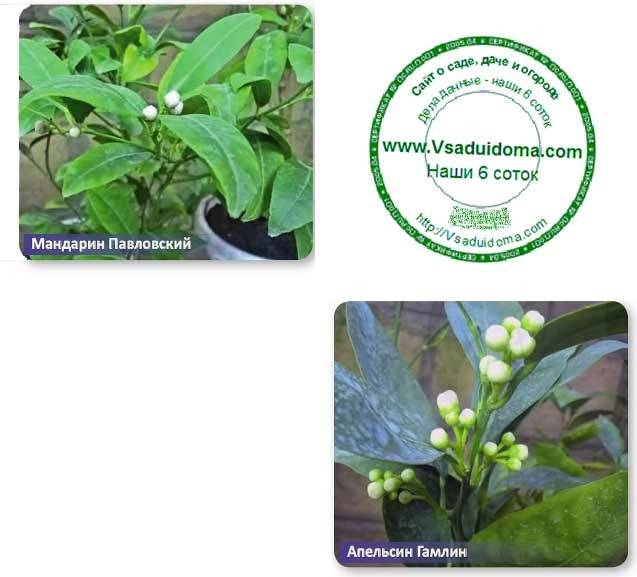

Vaccinations
Grafting allows you to transfer some varietal characteristics of one plant to another, accelerate fruiting and improve the quality of the fruit. Cuttings of fruiting plants are used as scions.
All types of citrus fruits can be grafted. Do not forget to remove rootstock shoots in time, which can stop the growth of the grafted cuttings.
For indoor citrus fruits budding (grafting with a bud taken from a cuttings of a cultivated plant) and copulation (grafting with a graft with the same thickness of the scion and rootstock). At the same time, some varieties of citrus fruits require a strictly defined rootstock. So, Lemon Panderoza is well suited for inoculating Kumquat, and Pompelmus for grapefruit. Sweet orange is used for grafting oranges and lemons.
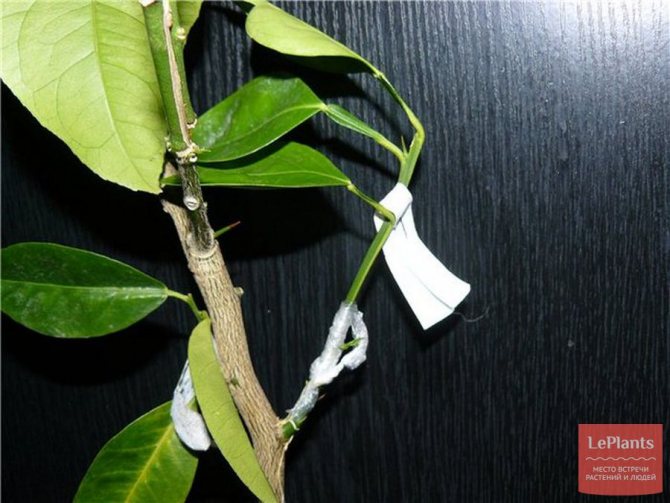

ON THE PICTURE: Tarocco orange grafted by copulation
Growing indoor tangerines
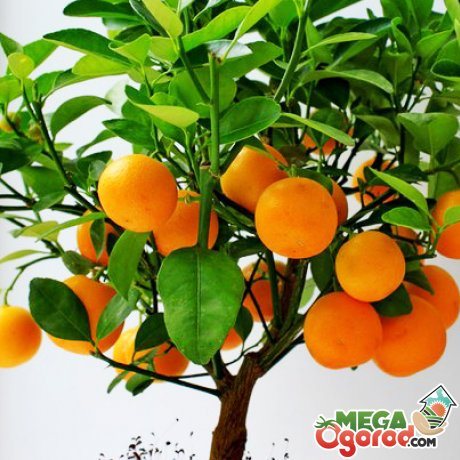

Indoor tangerines can be dwarf or common varieties: this plant has long been used for growing in a greenhouse and on a windowsill. Mandarin can be grown in the form of a bonsai - this is a special technology for forming a dwarf bush, which allows you to get a miniature tree that will bloom and bear fruit.
Mandarin is popular for its beautiful green leaves, white flowers with a pleasant smell, and fragrant fruits that can hang from the branches for several months.
The fruits of indoor tangerine have only decorative value: they are not worth eating because of their too sour taste. Improving the taste of mono fruit through selective work with several plants, however, it will take a very long time to develop a new variety. Taking care of indoor tangerine is not too difficult, you need to comply with several basic requirements:
- Regular, but not over-watering. The more leaves a plant has, the more actively they evaporate moisture, the required amount of water depends on this. In an apartment, it is advisable to spray the tangerine regularly, since the plant suffers from constantly dry air.
- Regular feeding with mineral soluble fertilizers. Mandarin especially needs a large amount of nutrients in spring, before flowering begins - at this time, watering with a fertilizer solution is carried out 1-2 times a week. Do not exceed the dosage: a large dose of fertilizers cannot be absorbed by the plant, and they can destroy the root system.
- Crown formation. If you purchased not a room, but a regular variety. The growth of several large branches should not be allowed: their tips are regularly pinched in order to achieve the appearance of lateral processes.
- On young plants, flowers and ovaries need to be controlled: the fewer fruits the plant has, the larger they will be, so excess ovaries must be removed in time. At first, only one ovary is left, the next year the number of fruits can be increased.
Constant care will make the tangerine strong and beautiful: it will decorate your home with dense foliage and gorgeous orange fruits with a pleasant smell. Growing a tangerine on a windowsill does not require much hassle: adherence to the basic principles of care will already allow you to quickly achieve good growth.
Top dressing citrus: fertilization scheme
Citrus trees need a lot of valuable elements. Citrus fruits quickly absorb the necessary substances, the earth is quickly depleted, respectively, nutrition should be carried out regularly. Full fertilization occurs during the growing season (early spring). Carry out food until autumn.
Fertilization chart
The older the plant and the longer it is in the same pot, the more it needs nutrition.
At the beginning of summer, feeding the tree is necessary to ensure the sugar content of the fruits, to reduce their bitterness, which is characteristic of indoor citrus fruits.
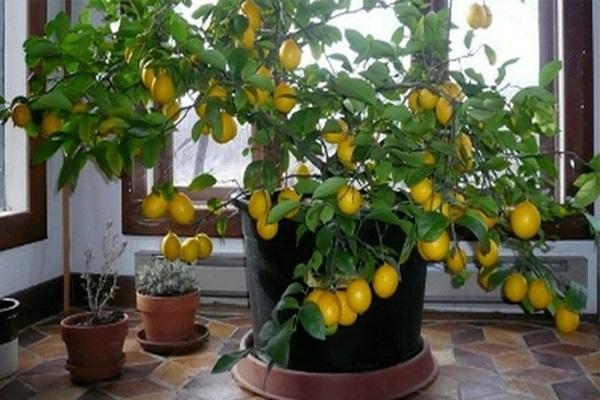

Top dressing procedure:
- Introduced with water.
- Only a healthy plant is fertilized. If the tree is sick, nutrition will only weaken the low immunity.
- During the wintering period, food is made no more than once.
- In the spring, when transplanting into a new pot, feeding is done only after 1.5 months. Mineral fertilizers are used for the flowering plant.
- If the tree does not bloom, it is necessary to add organic matter three times at intervals of 2 weeks. It is recommended to use horse manure, humus, vermicompost.
- Regularly from spring to autumn it is used: nitrogen and potassium - once every 10 days; superphosphate and slurry of manure - once every 4 days.
The grapefruit experience
This citrus made me very happy, but first things first. To plant the bone, I took the only grapefruit in the range of my refrigerator and removed the bone from it:
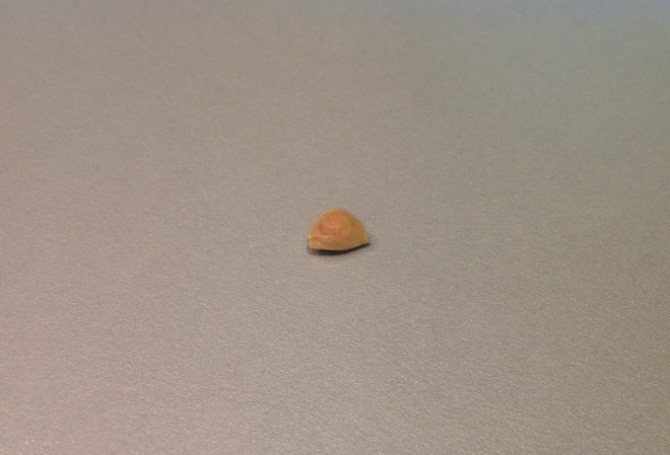

I thoroughly washed the bone with running water, and then simply stuck it into the ground ... Previously, I did not soak it in anything and did not process either the seed or the soil. By the way, I took the most common universal soil, and for planting I used just a microscopic container from a children's 50-gram curd. Didn't make any holes at the bottom, and didn't even put a drain.
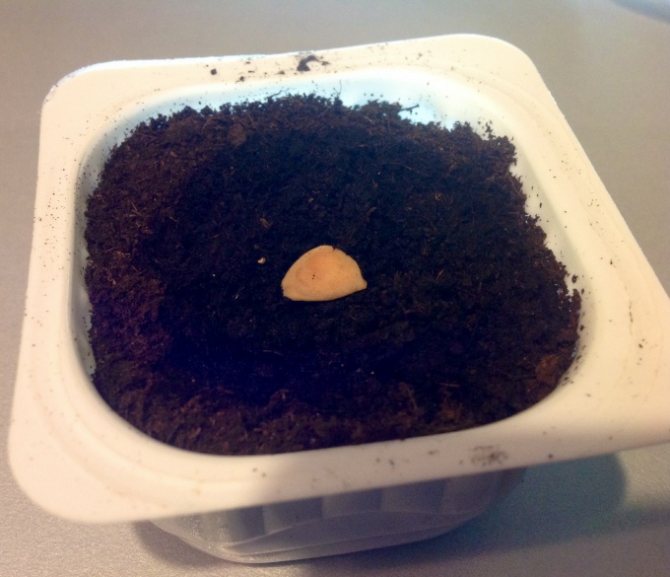

Then she dug in a seed, poured it on top, covered it with a bag and waited. It was February 2nd. To be honest, I did not expect to be successful, as I did everything very frivolously and lazily, but on February 23, I took off the package and found such a lovely picture:
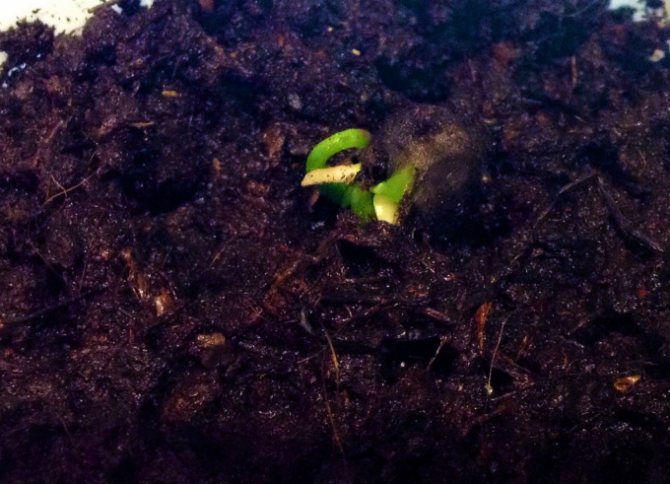

The seed, to my surprise, sprouted. After that, I took off the bag and just started to lightly water the sprout for further development. I watered with a syringe so as not to overdo it and not repeat the negative experience with sprouting mango seeds. About 3-4 days later, I noticed that real twins were growing from my bone. Before that, I had never encountered such a phenomenon in plants, although I know that in exceptional cases, one seed can give up to 4 shoots! Mine gave 2, and it looked amazingly attractive:
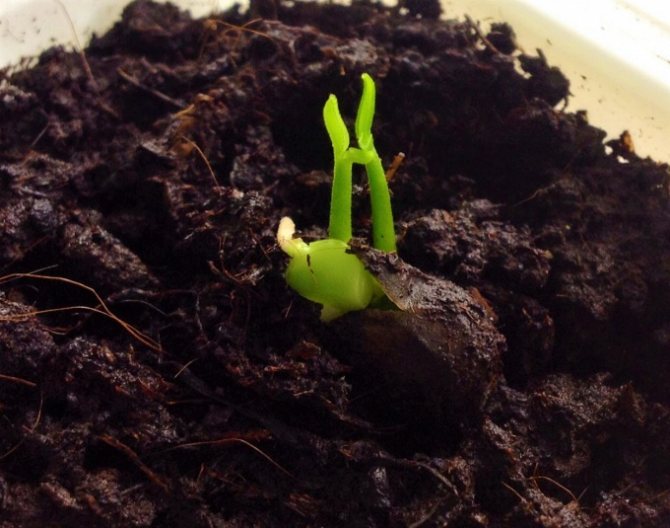

As time went on, my grapefruits grew stronger, they had the first solid-looking leaves, and then their development stopped. As I guess, this happened due to the fact that the root system of the plant simply stopped developing due to the small volume of the pot.
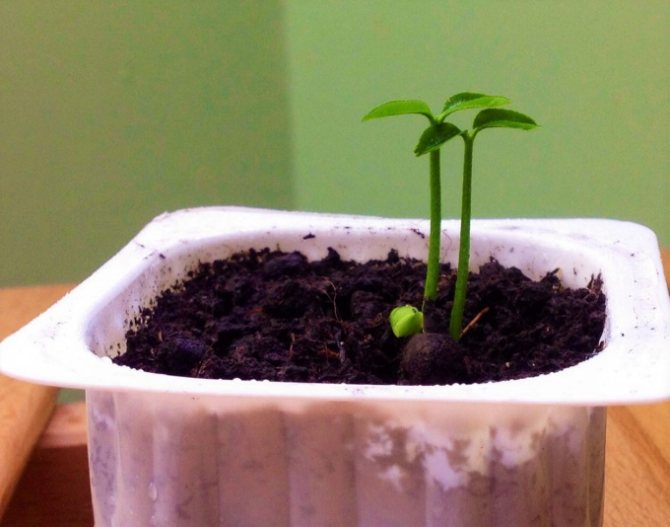

Choosing a place
Citrus lovers are partly lucky, because these plants are shade-tolerant, but they can thrive in a sunny place, so they can be placed near south-facing windows. As for the window that faces north, you should not put plants near it (with the exception of lemon and citron).
It is also not recommended to put a pot with the coveted plant near the microwave oven, there it will not grow, but wither, and it will not give fruit for sure.
Citrus plants from seeds. Citrus types
Every year after the New Year holidays, my sister and I entertained ourselves by planting seeds from eaten tangerines or lemons in a pot. They were terribly happy when the sprouts appeared. For some time we watched them grow, stretch. But we have never been able to grow a full-fledged fruitful tree. And all because such a sprout is a wild one. It must either be grafted onto another citrus tree or shaped using the correct pruning and forcing alternation.
You can also grow an exotic plant from a rooted cuttings. This is an even simpler and more efficient way. But no matter how you get the first sprout, it will depend on proper care whether you get a fruiting tree.
How to grow orange, grapefruit, lemon, date, kiwi, and even seed avocado
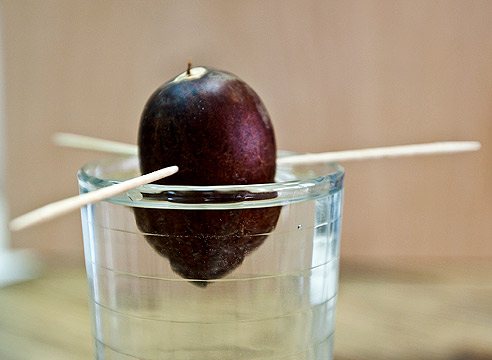

How to grow citrus fruits from seed
The first to attract the eye are all kinds of citrus fruits, the assortment of which practically does not depend on the season. The number of types and forms of modern citruses gives a lot of room for memory training: orange, tangerine, lemon, lime, grapefruit, mineola, clementine, calamondin, citron, orange, pomelo, kumquat. And in many of the eaten fruits, there are enough seeds. Experienced sowers advise holding the seed in your mouth for several minutes, and planting it immediately without drying it. Perhaps this is a relevant remark for some completely exotic citruses, in the genealogy of which you cannot figure out without a heraldic chamber. But lemons also grow beautifully from seeds that have been lying on a platter on the kitchen table for several days, waiting for their hands to reach their planting.
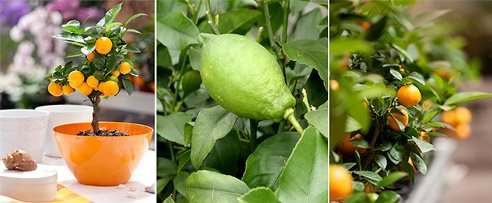

Another question is, which of the store citrus fruits will grow over time? Most of them in nature are huge trees, but what comes out of each specific bone is unpredictable. Your own copy can turn out to be quite compact and pretty. One thing: unvaccinated citrus is unlikely to bear fruit earlier than 7-10 years later, if you do not apply some effort. And then the harvest is unlikely to be impressive. Inoculating the same citrus wild, grown from eaten store fruit, can be about one and a half years of age. Lemon, for example, by this age grows about half a meter in height with a stem thickness of about 8 mm. If you get fired up with this idea, two questions will arise: what exactly to inoculate (what varieties of citrus fruits are bred specifically for the winter garden or room culture) and how to inoculate. The answer can be found in specialized literature or on the Internet. In the latter case, there is a chance to settle there forever, taking root in some citrus forum, where you will definitely learn a lot of new things. For example, where do they take trifoliate or bigardium, and at the same time, what is it, and why are they good as a stock with inedible fruits? And the list of hybrids will be replenished with limequat, oranjekatom, citrange, citrangella, limolays, limandarines and some kind of tangelo.
How to grow pomegranate from your own seeds
No worse than citrus fruits, seeds sprout from purchased pomegranates. Pomegranate, or pomegranate, in nature is much more modest in size than lemon, grapefruit or orange trees. Its seedlings are easier and more interesting to form: it itself willingly grows as a shrub or multi-stemmed tree. Young pomegranates begin to bloom earlier than citrus fruits, already for 3-4 years. This is a polyhomous plant: you can see three types of flowers on it - male, female and bisexual. Pomegranates (as the fruit is called), even if set, ripen for a very long time in room conditions. So if your goal is to eat pomegranates, then it's easier to buy them in the store. Even if you did not sow the seeds of the eaten fruit, but the seeds of one of the indoor varieties of dwarf pomegranate. But thanks to its visual appeal and potential longevity, the pomegranate seedling has every chance of becoming a universal favorite, which will be inherited by your grandchildren.
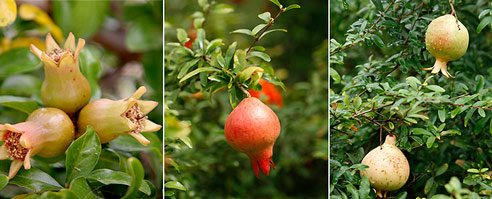

How to grow an avocado from a seed
Another fruit-vegetable that deserves the attention of beginners is the avocado or alligator pear. This tree belongs to the Laurel family, is called the American Perseus (Persea americana) and in nature grows up to 18 meters in height. It is much more fun to sprout than lemon or pomegranate. When buying, it is important to choose the right ripe fruit, otherwise the seed may not germinate. An unripe avocado fruit can be kept in the same container with a ripe banana for several days for it to come through. There are several ways to germinate a neatly extracted bone:
- stick the wide bottom part into the ground to a depth of 2-3 cm.If the shell is removed from the bone before planting, the process will go faster;
- insert two or three toothpicks or matches into the bone at the middle level. They will serve as supports for hanging it over a glass of water. The bottom of the bone should be in contact with the water, you will have to make sure that the water does not fall below a predetermined level. After two to three weeks, roots will appear and the seed can be moved to a pot of soil. When planting, the root that appears and the lower part are buried by 2-3 cm.Most of the bone should remain above the ground surface
- put the bone on a damp cloth or cotton wool and moisten it constantly. When the bone is divided into two parts, you can plant it in a pot.


Avocado seedlings look very exotic: the stem appears between the halves of the seed, which lies in the pot as a decoration. But this is the only decorative feature of the avocado as a houseplant. Perseus staunchly resists attempts to shape her by pinching. And although it grows powerfully and quickly, it never bears fruit at home. In contrast, a persimmon grown from a stone can even bloom in the 4th-6th year.
Growing kiwi from seeds
It takes some effort to extract the kiwi seeds. It is necessary to scrape out the core with small black seeds with a spoon, and then rinse without losing the mined fines. This is the most difficult step when sowing kiwi. The seeds of ripe fruits then sprout well and quickly. The main thing is not to bury them too deeply, it is enough to sprinkle 1-2 mm of substrate on top. Chinese actinidia (Actinidia chinensis) or gourmet actinidia (Actinidia deliciosa) will grow, close relatives of which successfully bear fruit in the gardens of central Russia.
Bloom
An orange tree, which is not very difficult to take care of at home, will give ovaries if the crown is correctly formed. This plant blooms and bears fruit on twigs at least five orders of magnitude, so you should not expect fruit to appear earlier than five years later. The crown is formed quite simply.
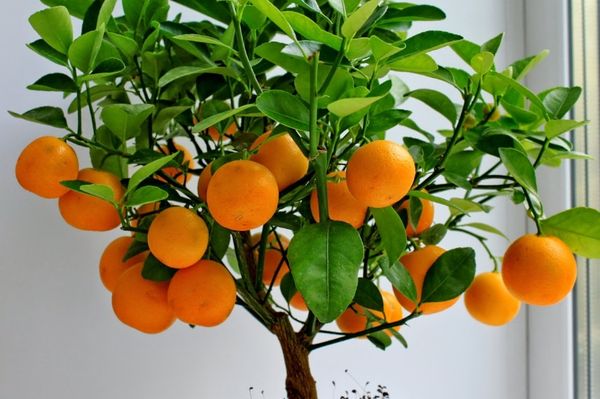

In this case, the room should be cool: 17-20 degrees. At higher temperatures, the fruits are not set, and the plant itself is sick or affected by pests.
How to get through the winter?
During the wintering period, the optimum temperature for citrus plants is about 10 ° C. Watering the tree is insignificant, you need to slightly moisten the soil. Low temperatures are important for full fruiting. If the temperature is high in winter, citrus trees may not bloom. Recommended plant location: cold loggias, insulated unheated balconies.
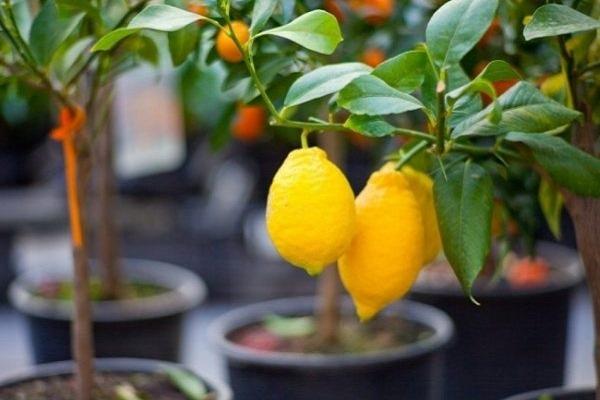

Success components
An important component of the successful cultivation of citrus at home is the humidity of the air, soil and the presence of fertilizing. Periodic spraying with warm water is the minimum that will allow the plant to feel comfortable.
As for soil moistening, there are some nuances here. Do not use water for irrigation just taken from the tap. Citrus fruits should be watered with water that has settled for several days, and even with the addition of a couple of drops of vinegar to it. If the fruits are exactly in your plans, then fertilizing should be the first in the list of works for the citrus plant. All exotics simply adore fertilizing with mineral fertilizers, they also love organic matter. Feeding can be done from February until the beginning of the dormant period.
Secrets of Successful Seed Citrus Growing
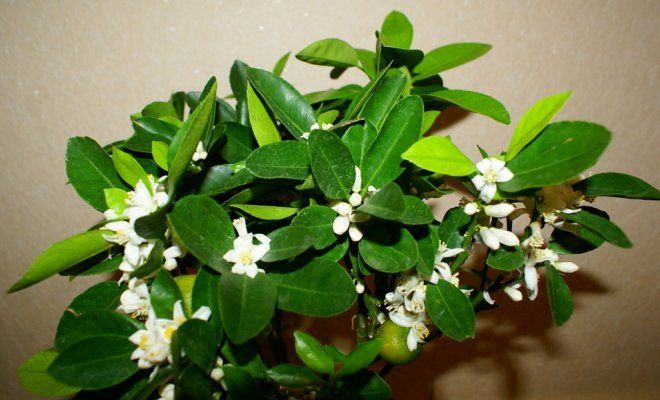

Citrus is the most popular and readily available crop for seed experiments. In addition, these plants purify the air well, so their maintenance at home is quite justified.
Citrus pits for sowing, you need to take from ripe fruits harvested on time, i.e. when in the middle lane the middle of winter. It is undesirable to use old, stale and rotten citruses - the seedlings will be weak and sick.
Before planting, the seeds are washed, peeling from the pulp, to prevent mold from the shell in the ground.Before planting, it is recommended to soak the seeds in warm water with the addition of a drop of Epin or Zircon. In general, they germinate no longer than 2 weeks.
The fastest are tangerines: they can germinate as early as 3-5 days. The longest time you have to wait for the germination of grapefruits, sweets, limequats, kumquats and other exotics.
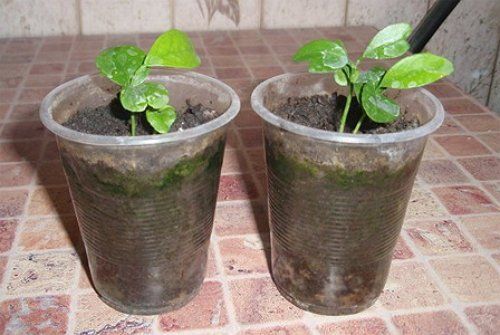

Pitted lemon
For germination vermiculite is best used for seeds, as it retains moisture well and does not contain organic particles that can rot and infect seedlings with mold. At the stage of appearance of the first leaf, citruses can be transplanted into the soil, in a separate pot. Seedlings need illumination and a temperature of at least 25 ° C, they do not tolerate drafts. Requirements to soil citrus fruits are: the soil in the pot should be loose and breathable (for this you can add the same vermiculite in proportions of 1: 4). To avoid stagnant water, be sure to do it in a pot drainage.
Lemon and tangerine the least capricious and better adapt to the conditions of the apartment than other citruses. Mandarin it is also the easiest to form by pinching the tops of the branches for further branching. And here lemon and grapefruit often get sick after this procedure, and new branches at the place of pinching do not appear immediately. Seedlings also respond well to pruning, picking and transplanting. miniolawhich is a hybrid of grapefruit and tangerine. Orange does not like drafts and abundant watering, preferring spraying.
Crown formation usually begins at the age of about six months, when the citrus has a stem (trunk) of sufficient height. It consists in pinching the branches growing in the right direction in time for their further branching, and do not forget to cut those branches that grow in the wrong direction or inside the crown. The branches are pinched, as a rule, over every 5th leaf.
A plant grown from a seed blooms in 3-5 years (not earlier). The longest wait is for the flowering of the hybrids and grapefruit. It often happens that they do not bloom even once in their entire life on the windowsill. And the easiest and fastest bloom and give fruits are lemon and kumquat. The general unpretentiousness of mandarin does not apply to flowering.
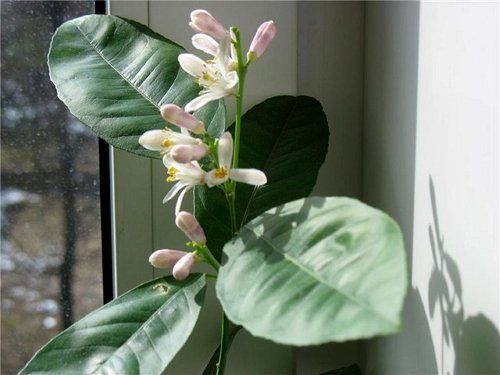

Flower buds in citrus fruits, they are already laid on branches of the 5th order, the stem itself is considered as the zero point of reference. Branches of the 1st order grow on it, they grow branches of the 2nd order on themselves, and with sufficient lighting and general health of the plant, buds appear already on the 5th generation of branches and subsequently fruits. Often citrus fruits bloom too abundantly, dying later with the set fruits from lack of strength. To prevent this from happening, extra flowers must be plucked out at the bud stage. The calculation is simple - there should be 10 healthy adult leaves for each flower.
indoor.
Orange
The orange tree in the apartment is not only a supplier of sweet fruits throughout the year, but also a source of wonderful aroma. However, the problem with the orange is its poor tolerance to low temperatures, which will require constant temperature maintenance at 18-24 degrees. In addition, an orange requires direct sunlight for at least 2 hours a day, but no more than 3 hours, which is difficult when choosing a growing location, since, with all this, the tree does not like anxiety and rearrangements.
This type of citrus fruit needs regular watering and spraying, which should be carried out at least 2 times a week. The best varieties of homemade oranges are Gamlin, Pear-shaped Korolek, Washington Navel and Adjarian.
It's all about the pot
Responsibly you need to approach the choice of dishes for your exotic. The best option for placing citrus fruits is a pot made of unglazed baked clay, as well as tightly knit wooden tubs, matched to the size of the root system.But whatever the pot may be - made of clay, made of wood - it must have good drainage and holes for the outflow of excess moisture.
For good fruiting, there must be excellent nutrition. For citrus fruits, regular soil from the garden will not work. The pot should be filled with a special citrus mixture. It is better not to make such a mixture on your own, but to purchase it in the store, it is inexpensive, but you will be sure that it will benefit the plant and will not harm it.
How to root a stalk
This is not at all difficult to do. You just need to make a cut with a sharp knife, not with scissors. The best time for rooting is May - June. Take a twig with ripe healthy leaves. Cuttings with a diameter of 5-7 mm will root best.
- Cut off the stalk with a sharp knife.
- We leave it to weather for an hour, we are not in a hurry to immediately stick it into the ground.
- If the cutting has to be transported, it must be wrapped in a wet cloth or placed in water. Upon arrival, the cut must be renewed and weathered.
- We stick the cutting into the ground (it is better to take the soil for citrus fruits) and squeeze it tightly around the cutting.
- Cover with a cut plastic bottle. Then, when the stalk takes root, you can unscrew the lid and only then remove the bottle. Mold often forms under the glass jar. So, I recommend using plastic bottles.
- When at least two months have passed, the cap on the bottle can be removed. It is better to do this gradually. First it is removed for half an hour, the next day for an hour, a week later for the whole day.
Citrus Diseases
Indoor trees: caring for the Arabica coffee plant at home
Diseases can be associated with physiological disorders caused by a deficiency or, conversely, an excess of trace elements.
Some signs of excess or deficiency of micronutrients:
- Mature leaves are dull and turn yellow. This is due to a lack of nitrogen. If there is a rapid growth of young shoots, the plant fattens and does not bloom, then an excess of nitrogen in the soil is possible.
- Leaves turn yellow and shrink, flowering is weak. Possible lack of phosphorus in the soil. With an excess of a trace element, the plant develops and grows poorly;
- The leaf plate warps, pits form on it, folds appear on the leaf along the veins, some of the branches die off, foliage falls off during the flowering period. This is possible due to a lack of potassium. With an excess of potassium, brown necrotic burns appear at the edges of the leaf;
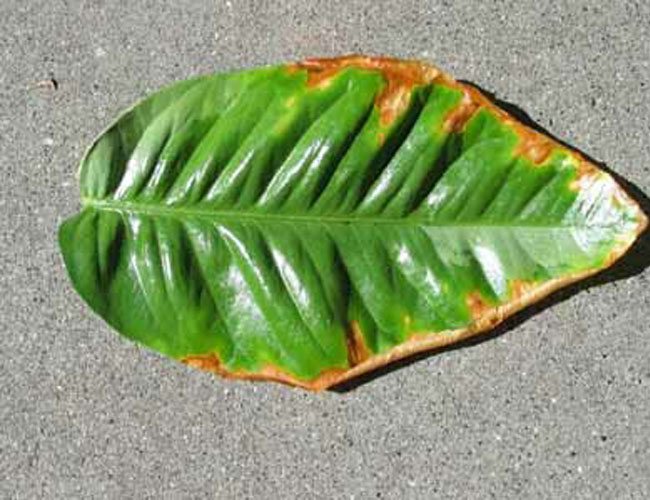

Lemon leaf with a lack of potassium
- The growth of defective young leaves, the death of growth points are provoked by a lack of calcium and boron;
- With a lack of iron, manganese, zinc or sulfur, leaf chlorosis is observed (green veins are clearly visible on yellow leaves), young shoots die off.
Citrus plant disease can be caused by pests. These include:
- scale and pseudo-scale (the appearance of wax plaques on leaves and branches);
- mealybug (the appearance of white lumps in the axils of the leaves);
- aphids (clusters of small black insects on young shoots);
- spider mite (yellow dots form on the leaves, white bloom appears below).
Fungal diseases include:
- malseko (the branches turn black, then they begin to dry);
- gum removal (the appearance of fluid from the wound on the branches and trunk);
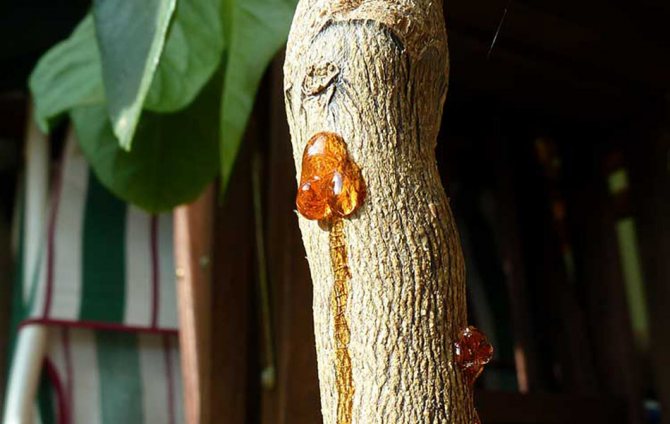

Gum therapy
- anthractosis (the appearance of wet spots on the leaf, which eventually merge into one);
- powdery mildew (white bloom on the leaves).
If a disease is detected, it is necessary to adjust the watering and feeding of the plant. In case of fungal diseases, damaged branches are removed and sprayed with fungicides.
Pruning and shaping the crown
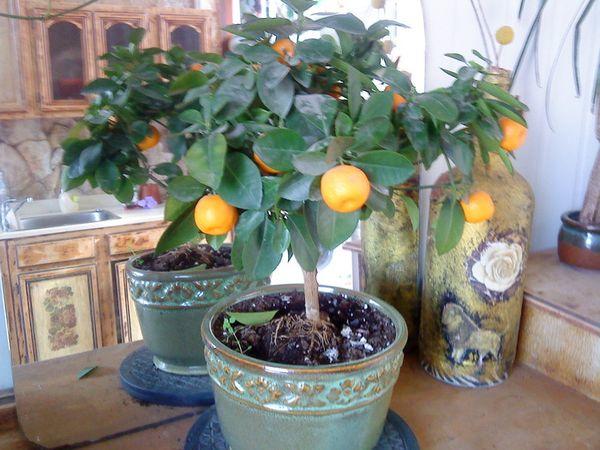

Young plants need crown formation, therefore, before the start of the period of intensive growth (mid-February), their shoots are cut off. If citrus grew from a seed at home, then in the first year of life it usually reached a height of 25–30 cm. Pinching the upper kidney slows down growth upward, activates the lateral buds.Then you need to form skeletal branches, for which several side shoots are selected, and the rest are cut off. Skeletal branches are gradually strengthened, they are shortened to force them to branch, to form as many small fruit branches as possible.

